This week, we made our way to central Turkey's popular Cappadocia region. The region is famous for buildings carved into rock and interesting erosion patterns. Both are made possible by the relatively soft tuff rock geology created by volcanic ash ejected from the now extinct volcanos in the region long ago. Being inland and at a higher elevation of around 1000m, despite being hot during the day temperatures dropped to about 10°C at night giving a welcome reprieve from the heat of the Turkish summer. We booked a hotel for a week and were eager to stay in one place for a while after moving every couple of days for over a week previously.
We got an absolute steal of a deal on our hotel through Booking.com. The combination of a solid discount, a free room upgrade, and free breakfast saw us paying €210 for the week in what seemed like luxury! Although the staff at Mial Cappdocia View Hotel spoke minimal English, we were welcomed warmly, managed to communicate using Google translate, and had a very comfortable stay.
23-June-2025: White, Love, Görkündere, and Pigeon Valleys
To take advantage of the cool morning temperatures (and to minimize the risk of sunburn) we woke up at 4:30am and set off for a hike through the oft-photographed Cappadocian valleys. With the sky gently brightening with arrival of twilight, we descended from Uçhisar beside the rock carved dwellings and eroded spires that sit below the town’s castle (which is also cut into the rock). As we set off for our hike, the famous Cappadocian hot air balloons started launching. Our path through White and Love valleys brought us directly under their flight path and near to the landing points - the perfect place to watch the flock of balloons float through the morning light.
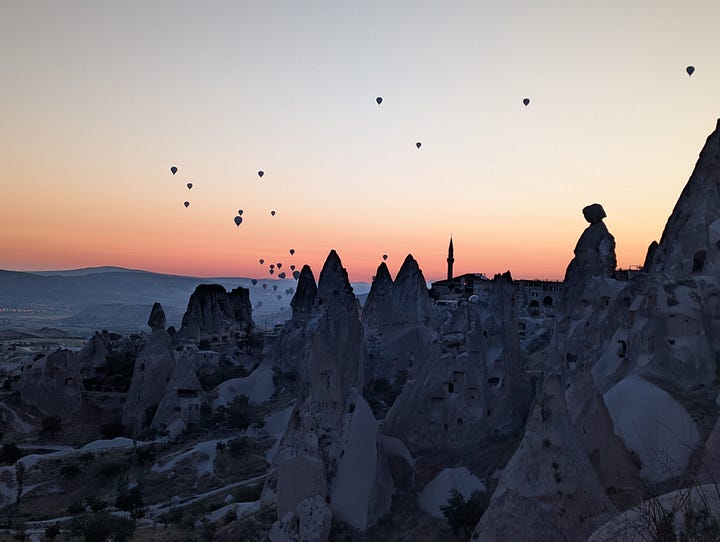
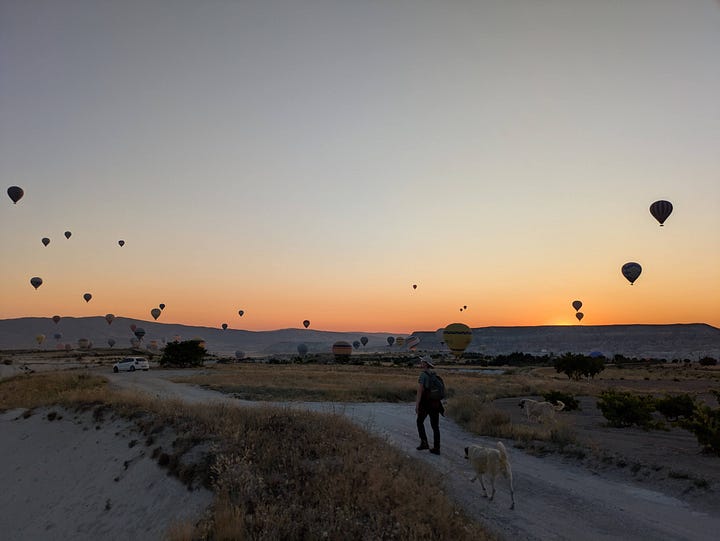
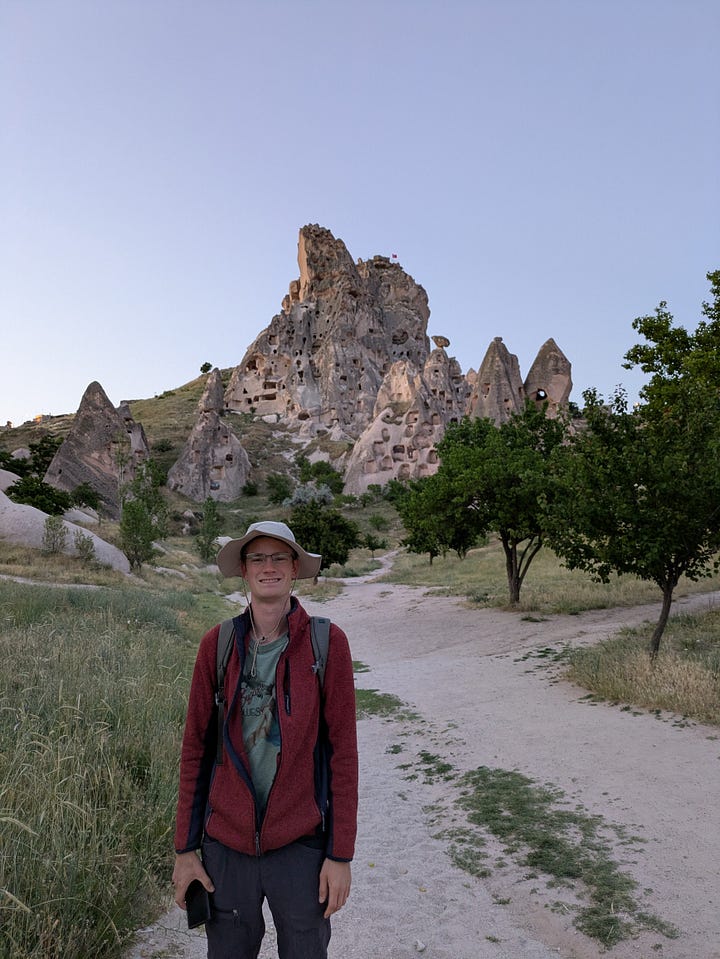
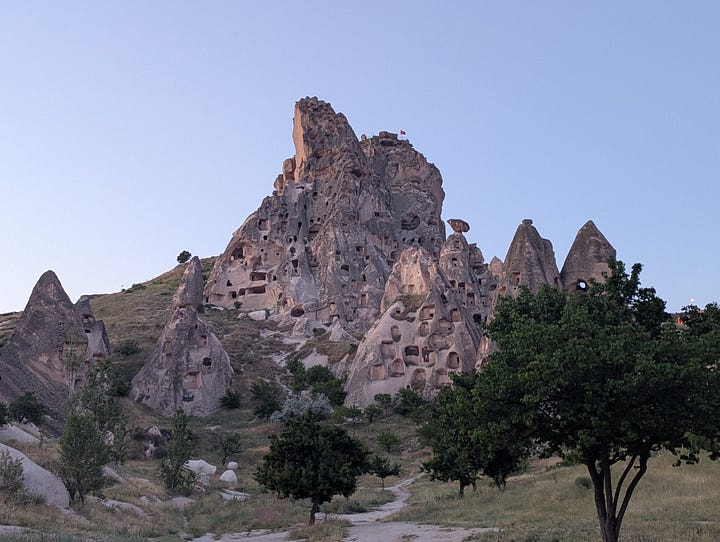
As we descended into White valley a couple of rather large but (luckily) friendly dogs started following us. We seem to be magnets for stray dogs… both in Montenegro’s Durmitor National Park and now in Cappadocia, the four legged creatures seemed to prefer to follow us rather than the others we passed along the trail. We followed the valley bottom and got closer to the paths of the balloons as it turned into Love Valley. The “fairy chimneys” of Love Valley provide a grand finale for those shelling out €120 per person for the hour long balloon journey - the balloon pilots descend surprisingly deep into the valley, passing precariously close to the pointy rock formations before rising out of the valley to land on its western edge.
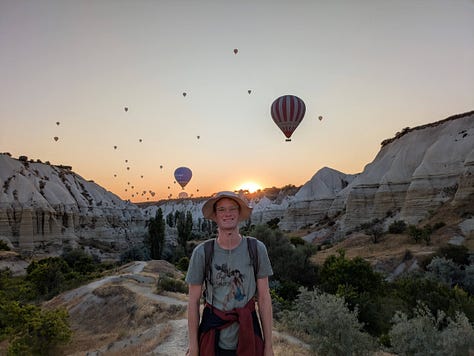
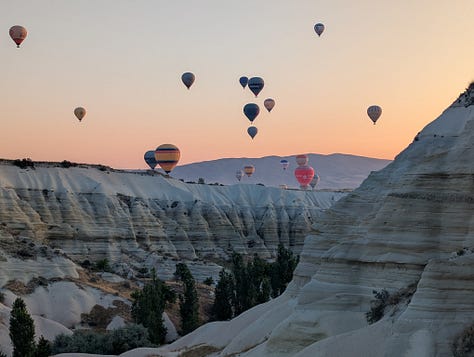
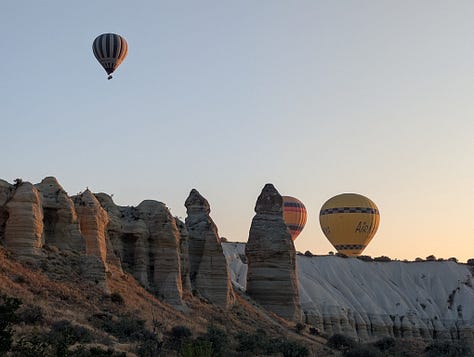
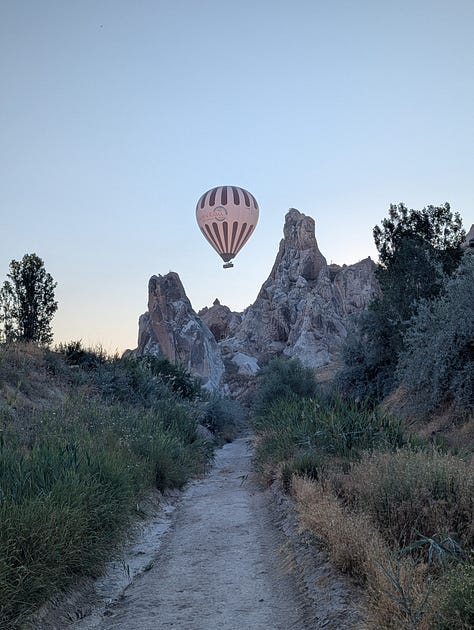
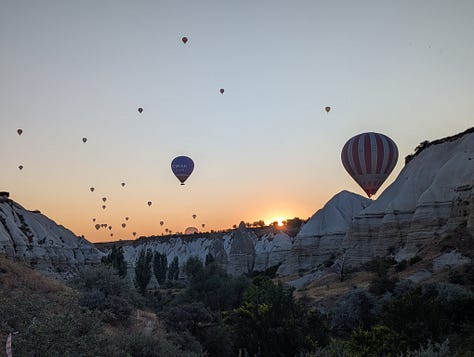
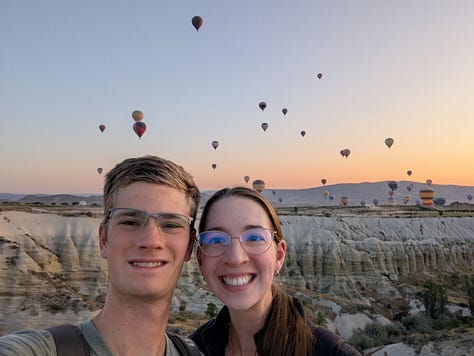
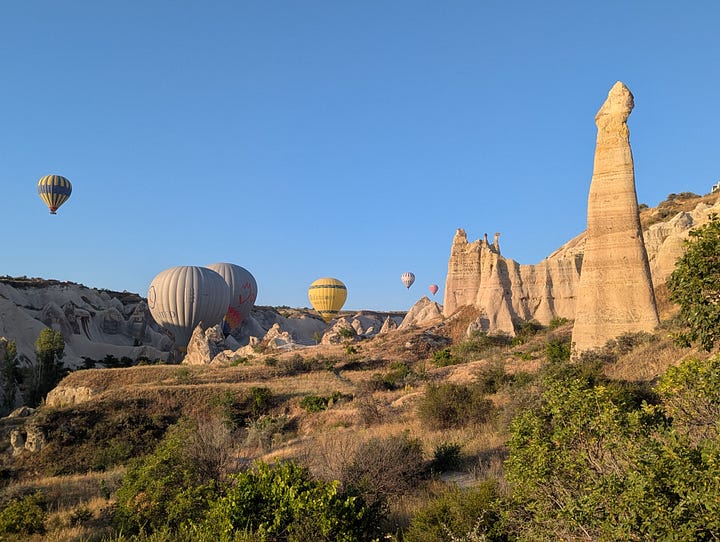

The fame of the Cappadocian balloons as an Instagram backdrop was evident as we progressed through the valley. Despite the early hour, we saw lots of people on the tops of the valley watching the balloons and posing for Instagram pictures. There are dirt roads along the valley's edge, so presumably these folks took the easy way to their photo spot (at least we expect the guy holding a massive mirror to get the perfect lighting for his female friend didn't carry it for miles). In the valley, however, we were alone - with the exception of the two or sometimes three dogs trotting along with us.
At the end of Love Valley, we crossed the main road running from Göreme to Avanos and followed some dirt tracks past pens of horses used for tours through the area. This section of our walk was not particularly interesting - the 3km or so along roads and between valleys seemed especially boring compared to the spectacle of balloons and rock formations earlier in the morning.
Fortunately, the dull surroundings didn't last too long. We soon reached more structures cut into the rock as we approached Görkündere Valley. None of the structures had any information regarding what their former use may have been. To an untrained eye, houses, agricultural buildings, or storage spaces would likely look like a similarly dark cave. Some of the man made caves we passed seemed to have graves cut into the floor, so perhaps these were part of a church complex of some description.
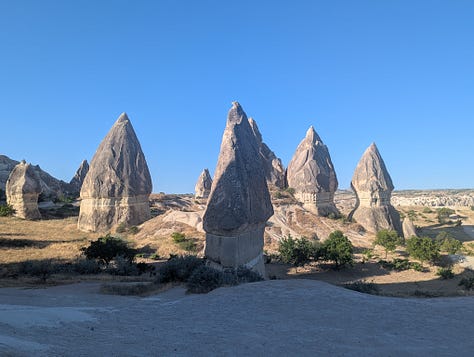
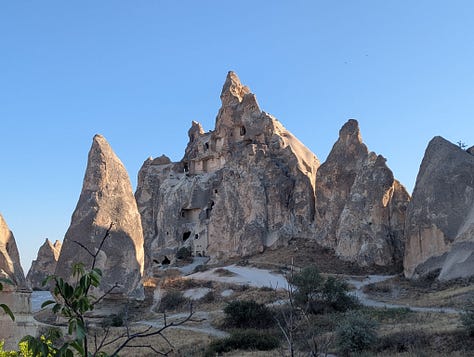

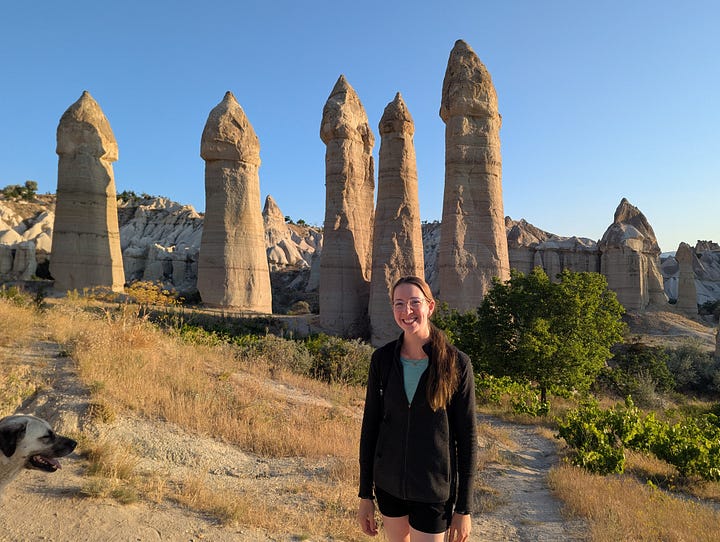
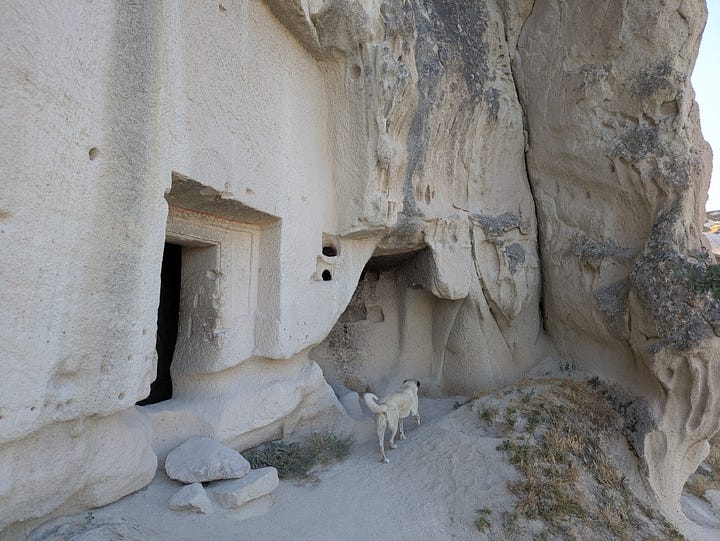
Görkündere Valley itself is small, but the “Fairy Chimneys” (or phallus shaped rocks if your mind is in the gutter) provided the most spectacular scenery as we climbed out of the valley and to the ridge over Göreme. Göreme is the main tourist town in the area, and this was clear as we entered. Every building seemed to be either a fancy hotel, a restaurant, a tour guide agency, or a souvenir shop - many partially make use of caves for their facilities.
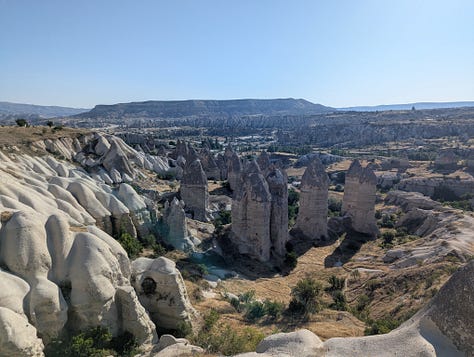
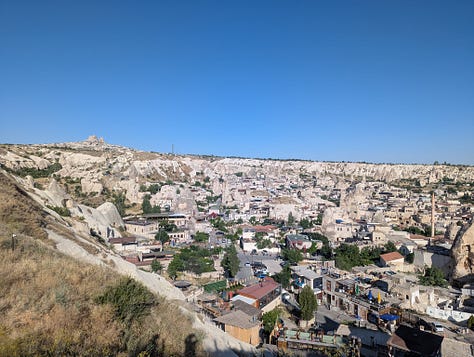
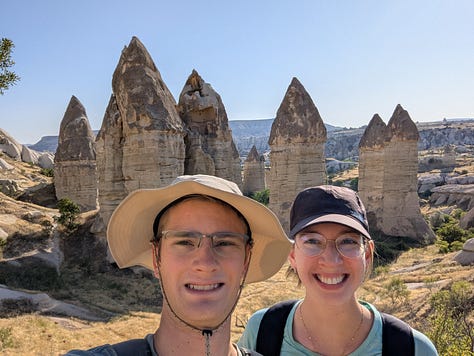
At the edge of town, we reached Pigeon Valley. Named for structures cut into the rock for keeping pigeons (a sign said they were a valuable source of fertilizer for the fields), the valley climbs towards Uçhisar. Although pleasant, pigeon valley wasn't quite as spectacular as the others we walked today. The stone walls of the valley are smoother and there is a distinct lack of otherworldly eroded formations. We returned back to our hotel at about 9:30am, just in time to have a shower and enjoy the massive Turkish breakfast.


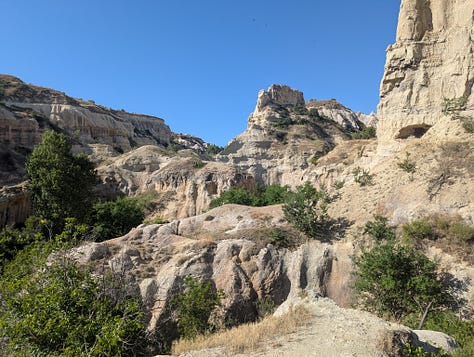
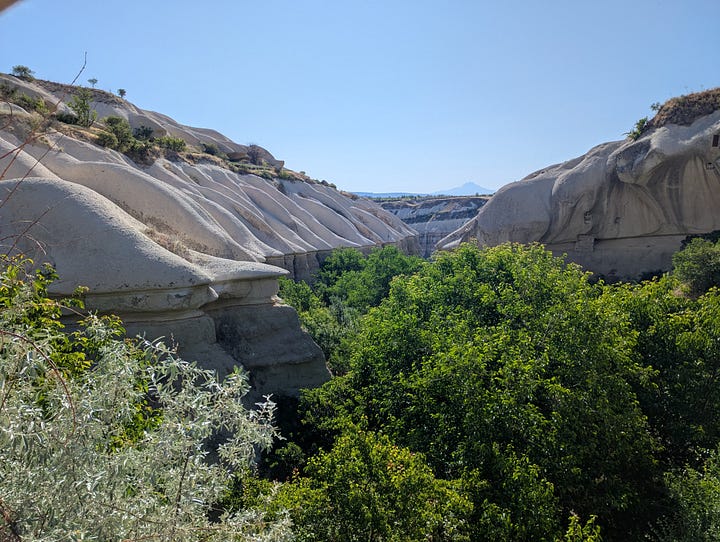

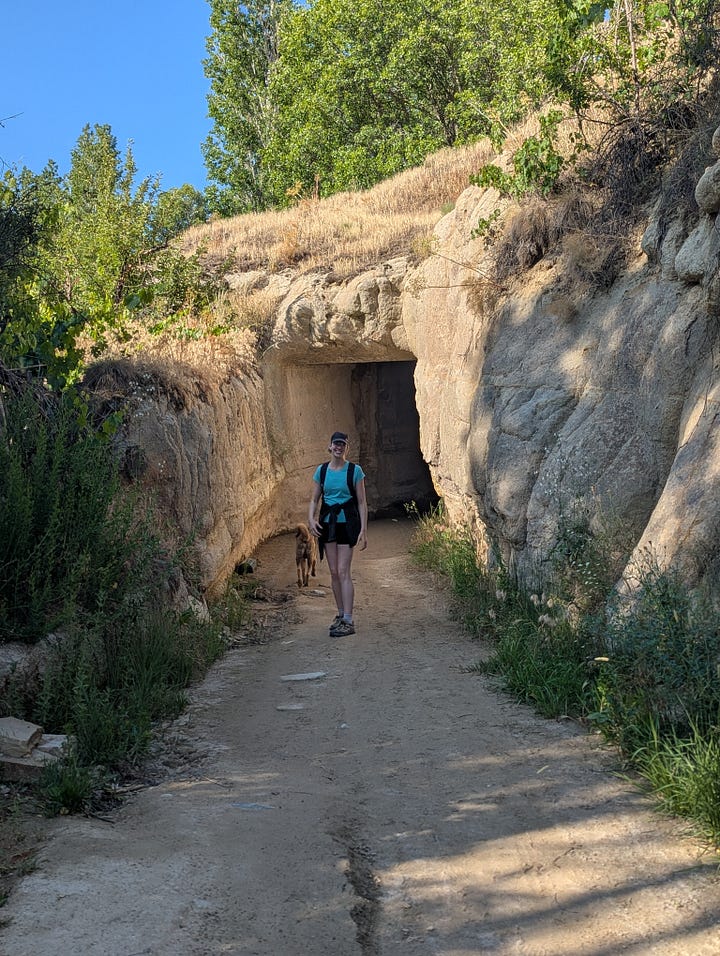
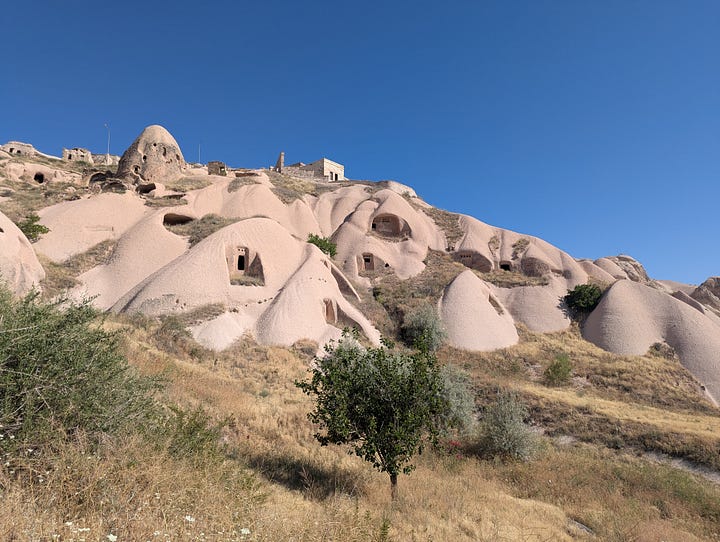
24-June-2025: Zemi, Rose, Red, and Meskendir Valleys
We woke up even earlier in order to take on a longer walk through more of the area’s famous valleys. The 3:30 am alarm jolted us awake and we were out the door by 4 am. It was dark when we set out with the eastern horizon just showing the first signs of light - this was slightly unfortunate as it was too bright to see many stars, but also dark enough that obstacles on the path were difficult to identify. We walked through Uçhisar which was deserted other than a few vans presumably shuttling people to hot air balloons for the morning’s launch.
After following a track along the ridge between valleys, we plunged into Zemi Valley. The the white rock and chalk coloured sand gave way to lush vegetation - trees, bushes, grasses, and wildflowers - in the oasis fed by a trickle of water along the valley floor. Zemi Valley is narrow and the rock formations are slightly less impressive than elsewhere we've been. The quietness and birdsong in the valley makes up for this, as do two interesting churches cut into the rock.
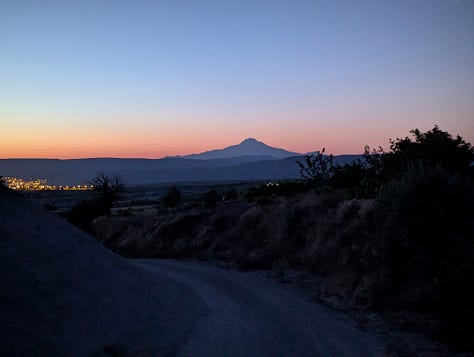
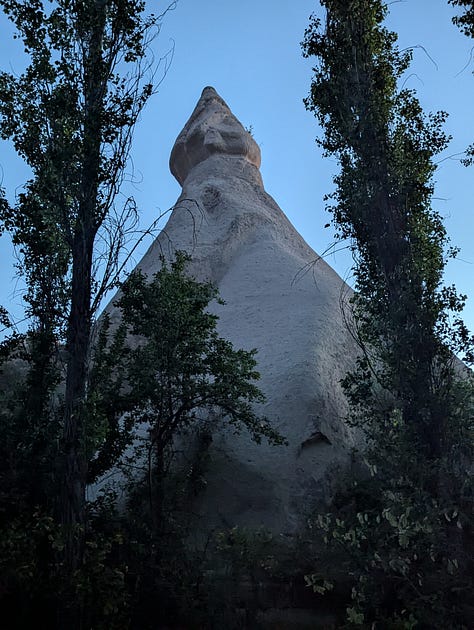
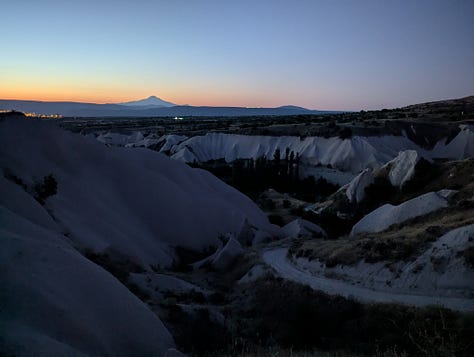
First we visited Karabulut (“Black Cloud”) Church; cut into the top of a pyramid of rock, the church was a bit difficult to access and required climbing up some well worn holds in the rock. Information about the church is hard to come by, which we soon learned is a bit of a recurring trend in Cappadocia. One website suggested it was carved in the 10th century and another said it was damaged by illegal excavations carried out by grave robbers in 2018. The church’s interior is small due to its location and a small collection of (damaged) frescos can be seen on its walls.
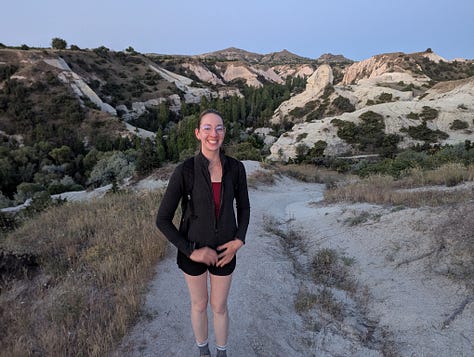

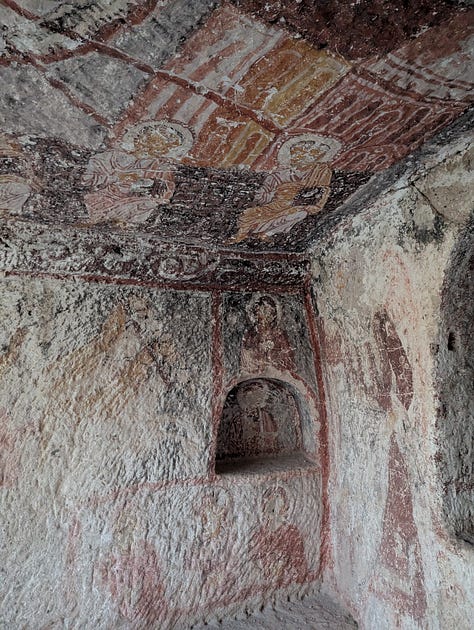
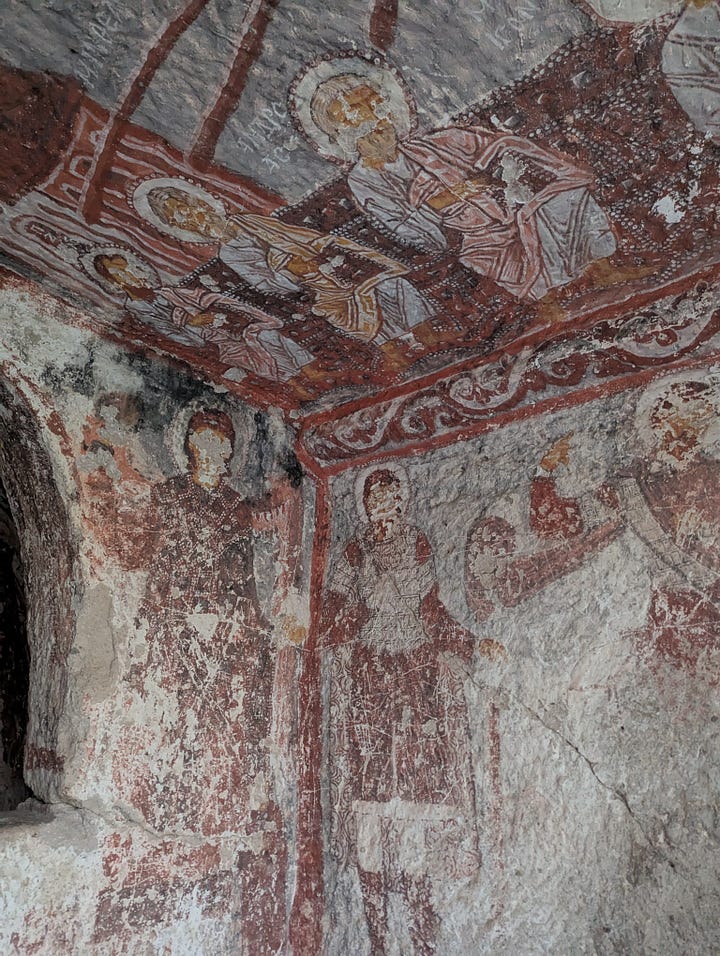
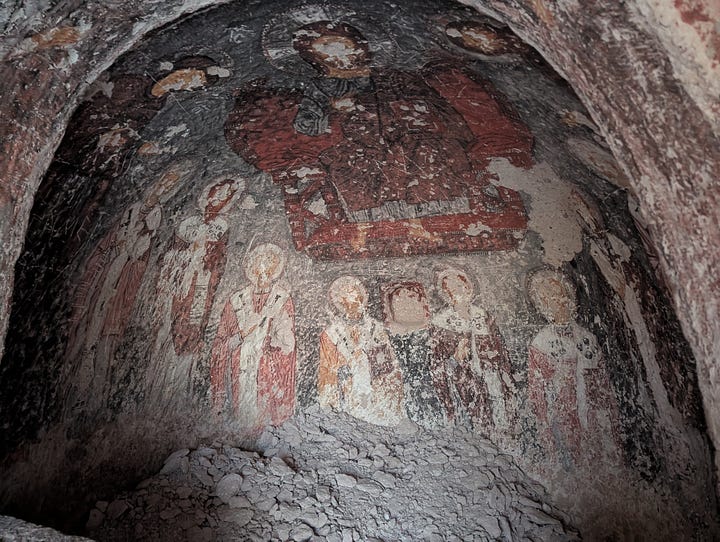
Nearby is the Cistern Church which gets its name from use as a cistern after it was no longer used as a church. The church was a bit difficult to locate as the entrance is small and other more obvious buildings (which various websites claim used to be part of a monastic community founded in the 11th century) are nearby. Inside the small entrance, the church opens to a fairly large space. Stored water damaged some of the lower frescos, but those that remain are impressive and in better condition than the nearby Karabulut church.
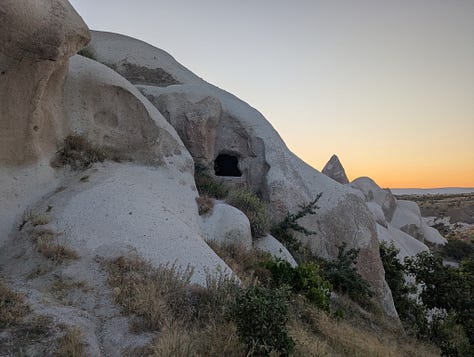
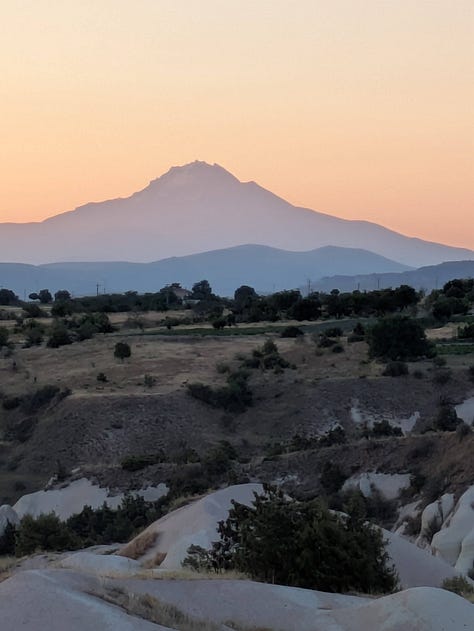
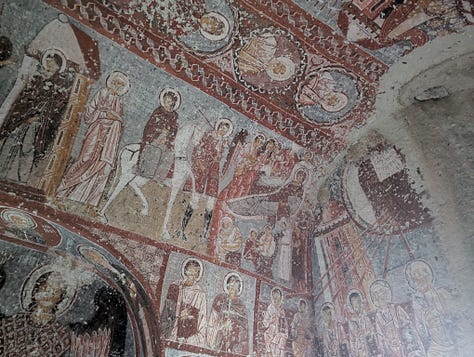
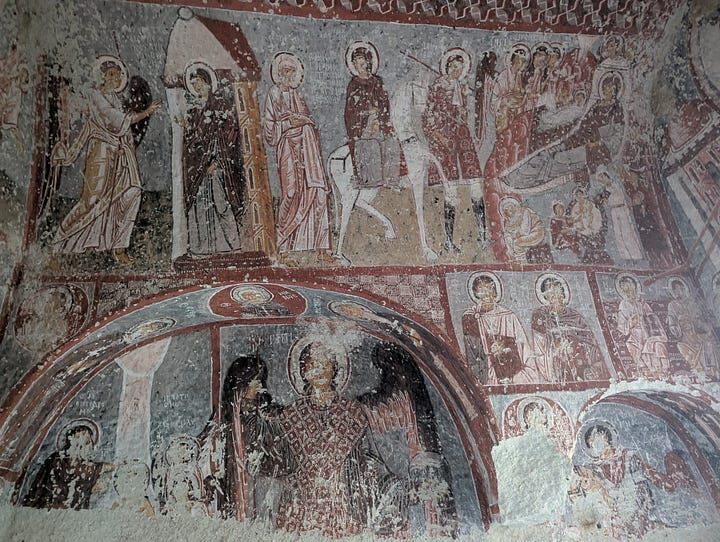
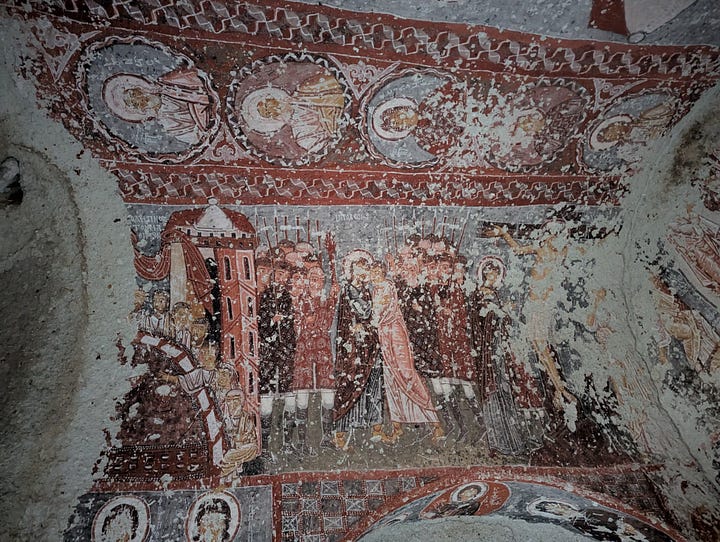
We continued through the lower portion of Zemi Valley, past a few narrow sections with signs warning of falling rocks - luckily we didn't encounter any while passing through. Eventually we reached the road between Göreme and the open air museum (which we didn't feel the need to visit as it costs €20 and was closed at this early hour anyway). We followed a road along another ridge between valleys which seemed to be popular for people in camper vans. It was a fairly pretty location, with views over Göreme to the west and Rose, Red, and Meskendir Valleys to the east. We caught a glimpse of the last few hot air balloons in the sky before descending towards Rose Valley.

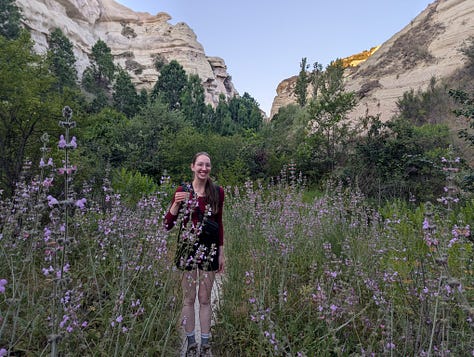
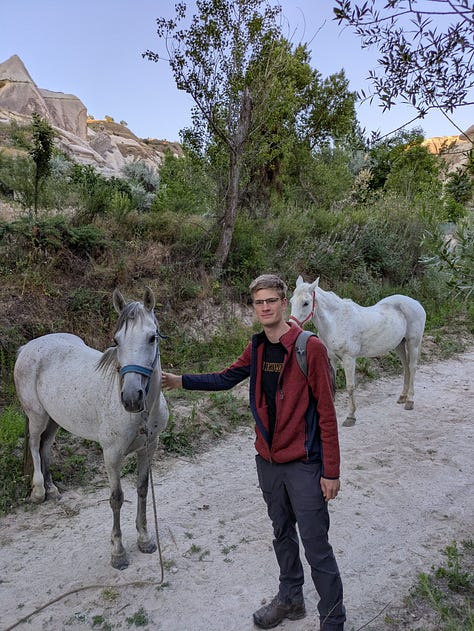
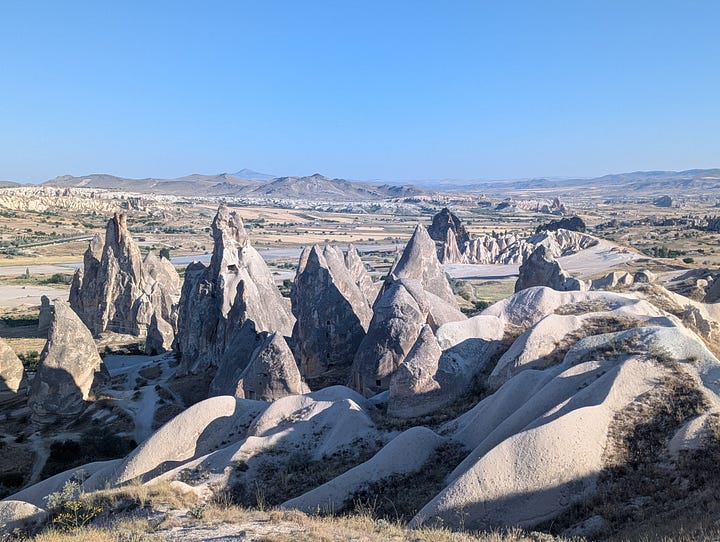
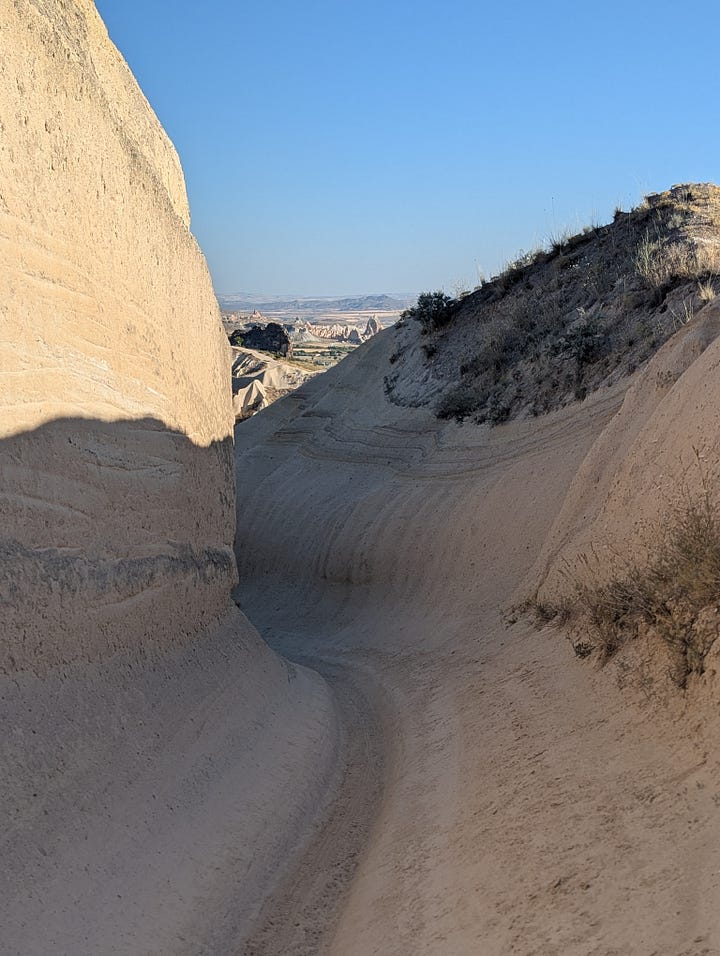
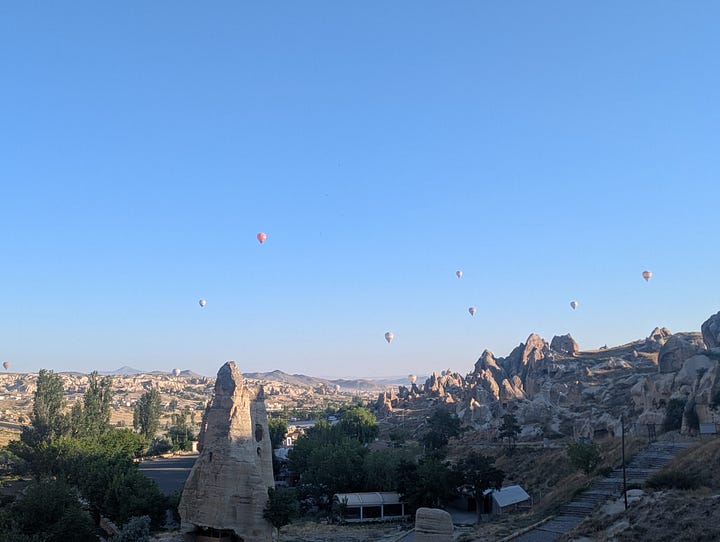
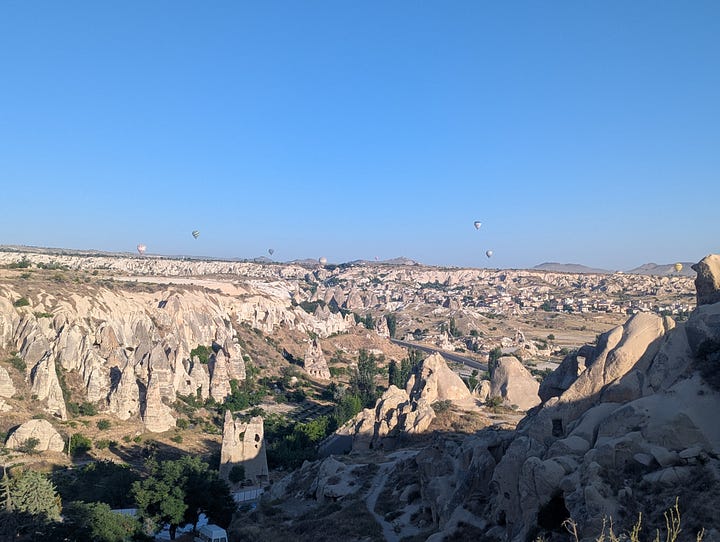
The remainder of the walk was not particularly well marked and there were a number of crisscrossing paths in the area. Luckily our map was pretty good and we could find our way on roughly the intended route. We looped through Rose Valley to see the Church of Three Crosses. The church is part of a larger cave complex thought to have possibly been a monastery. Although the condition of the remaining frescos in the church is extremely poor, the 10th century church has some of the most ornate relief carvings in Cappadocia. Three stunning crosses are carved into the roof of the church and thanks to their relative protection from the elements (and being out of reach of those that like to add graffiti carvings) they are in very good condition.
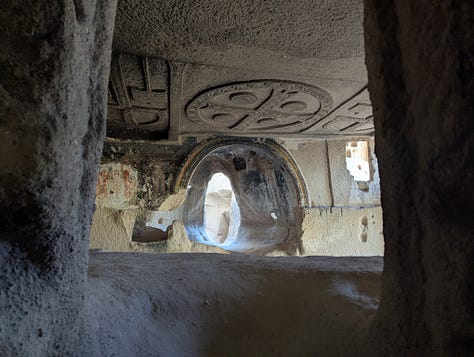
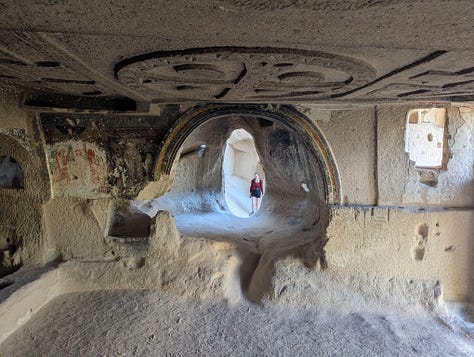
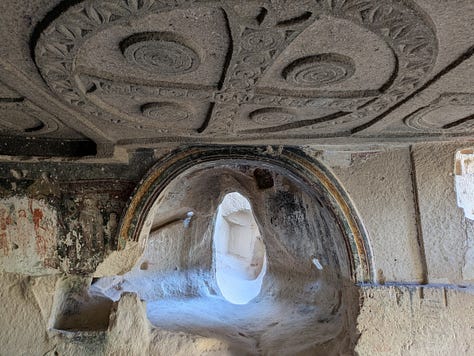

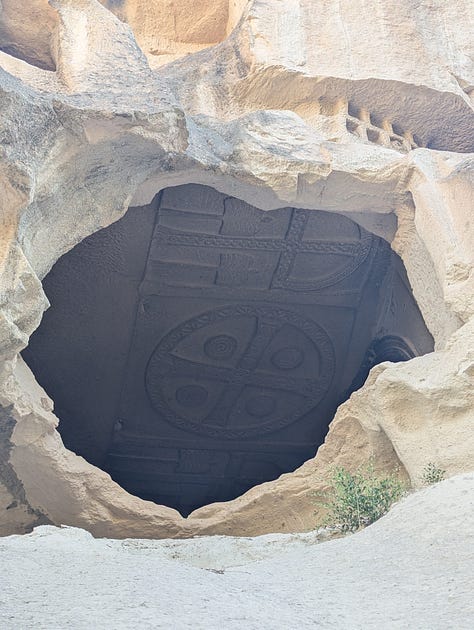
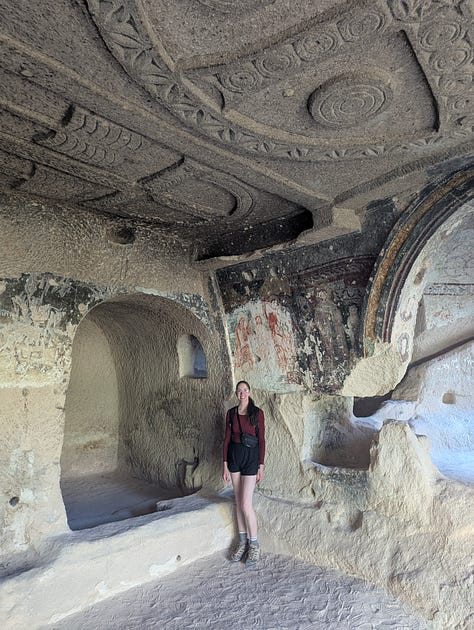
We climbed from Rose Valley into Red Valley to visit our fourth church of the day - Cross Church. This church features a less ornate cross on the ceiling and a frescoed apse in reasonable condition. A few other cave buildings are also accessible nearby and the church's location give a nice view down over Red Valley.
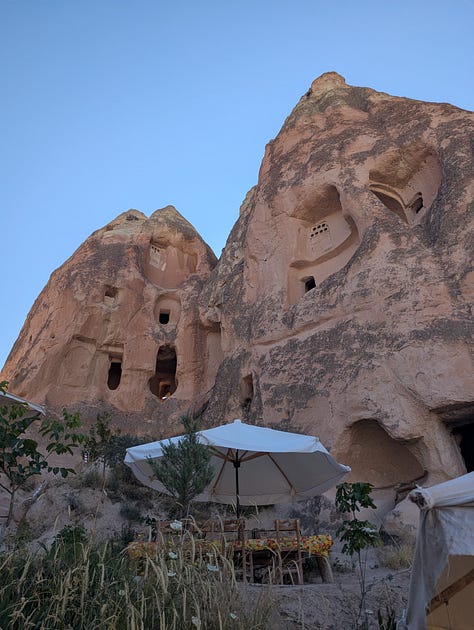
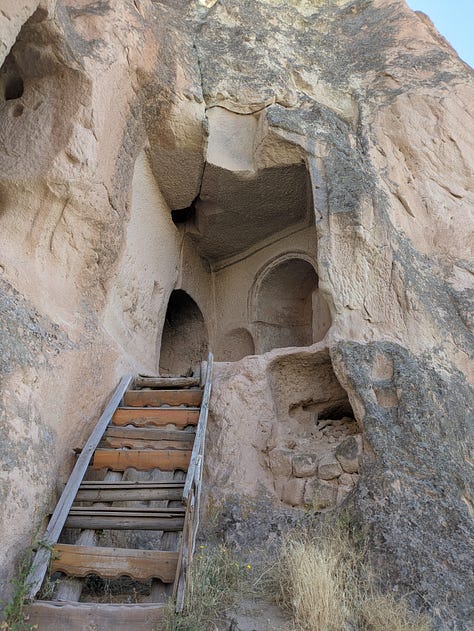
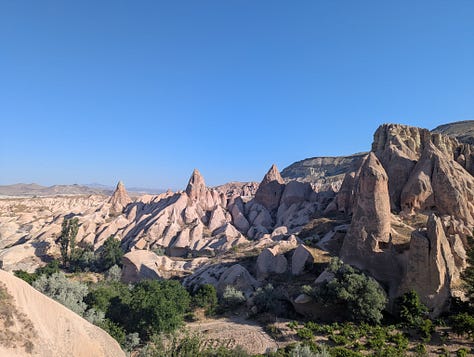
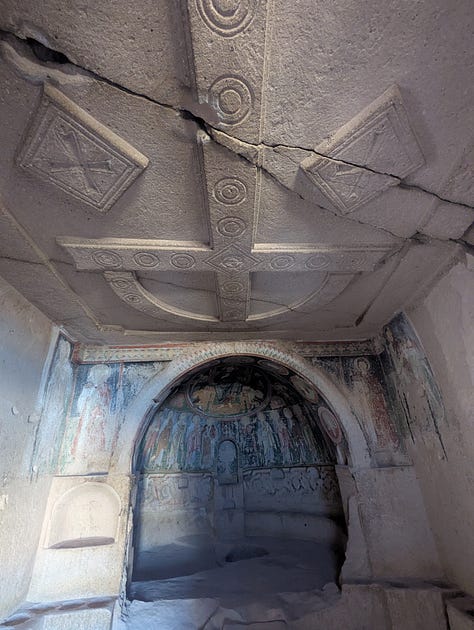
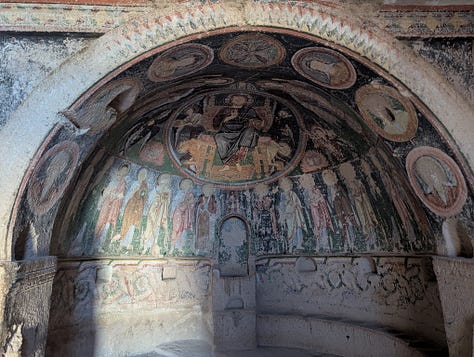
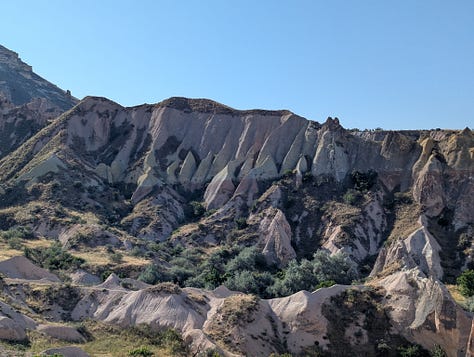
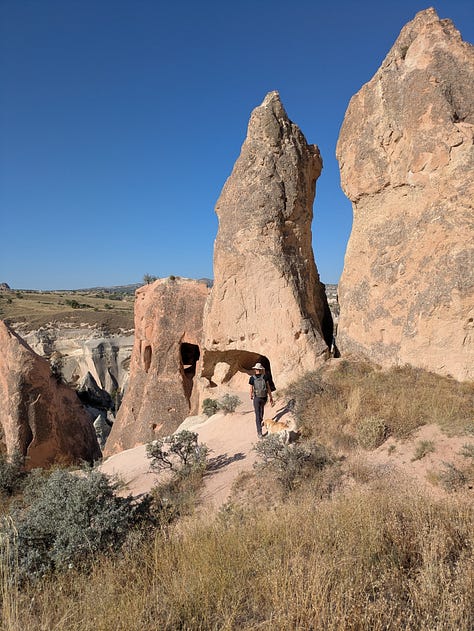

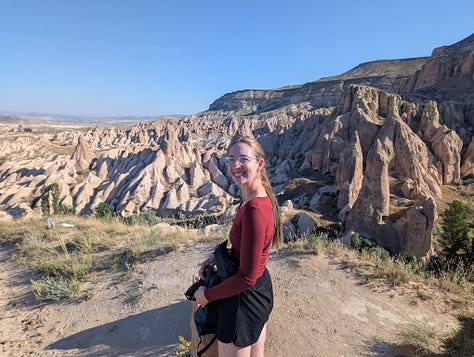
Our fifth and final church of the day was Column Church. The church is accessed via a small wooden bridge of somewhat questionable structural integrity, but the crossing wasn't too bad in the end (we went one at a time just to be safe). The church gets its name from massive columns carved to support the main area of the church. Some of the other areas are also decorated with carved columns. Despite the lack of frescos or particular intricate carvings, the size and scale of Column Church made it worth a visit.
From column church, we made a slight detour to find a safe looking path to the bottom of Red Valley. At this point, we realized we would be tight to make it back to our hotel for breakfast hours. We walked very quickly through the valley bottom then through Meskendir Valley and into Göreme, arriving just in time to catch the 10am bus up the hill to Uçhisar and get our breakfast order in at the hotel.
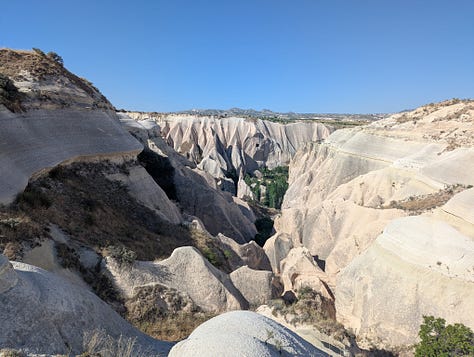
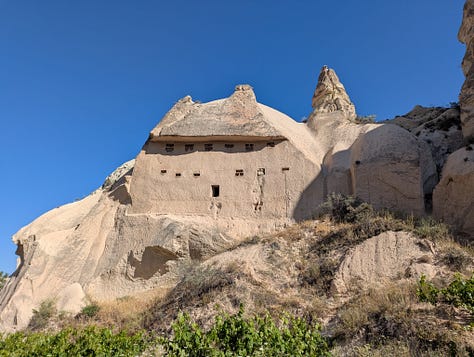

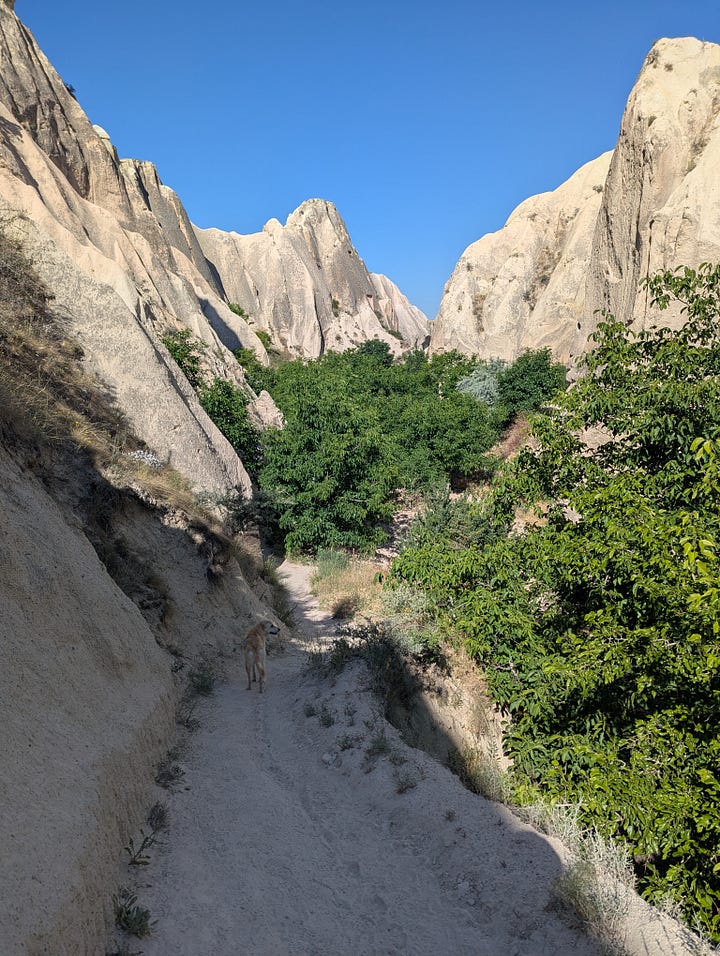
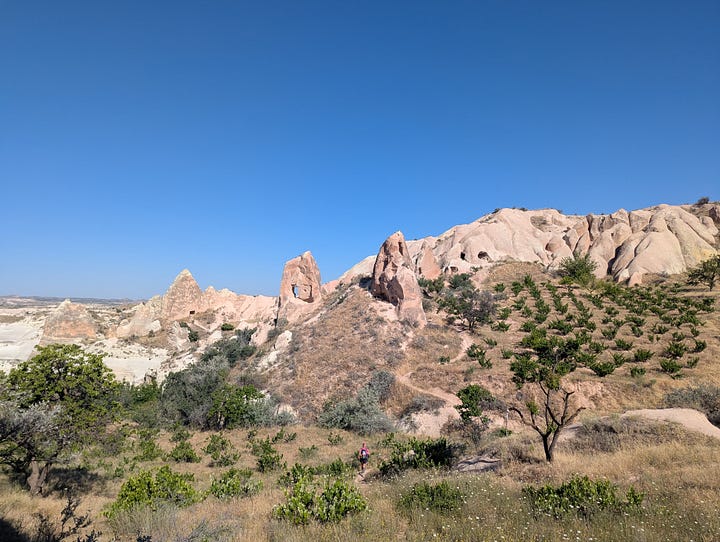
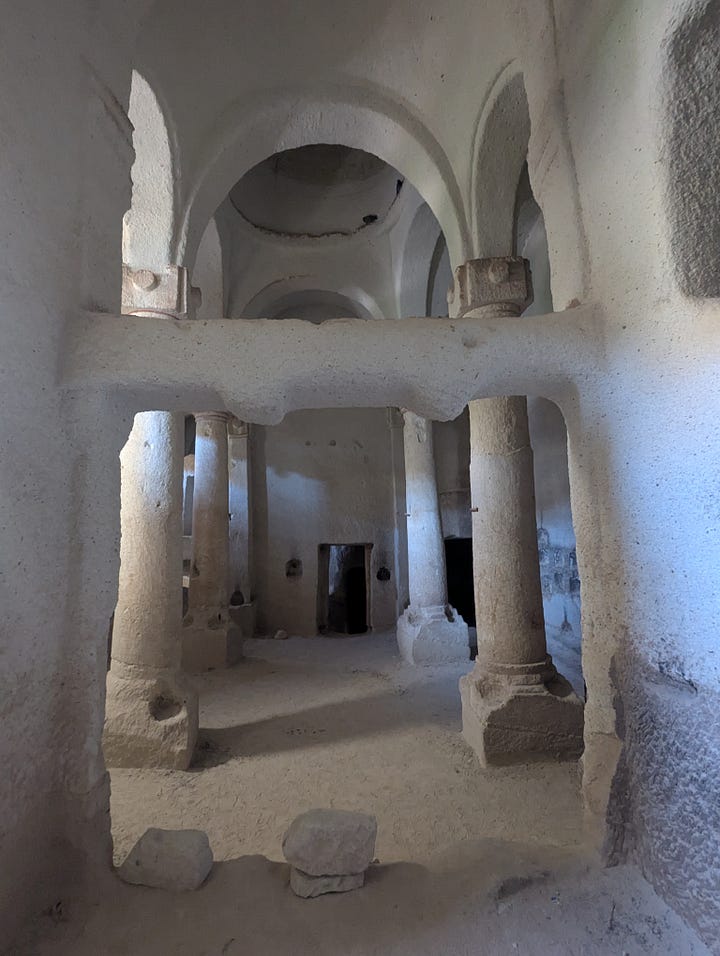
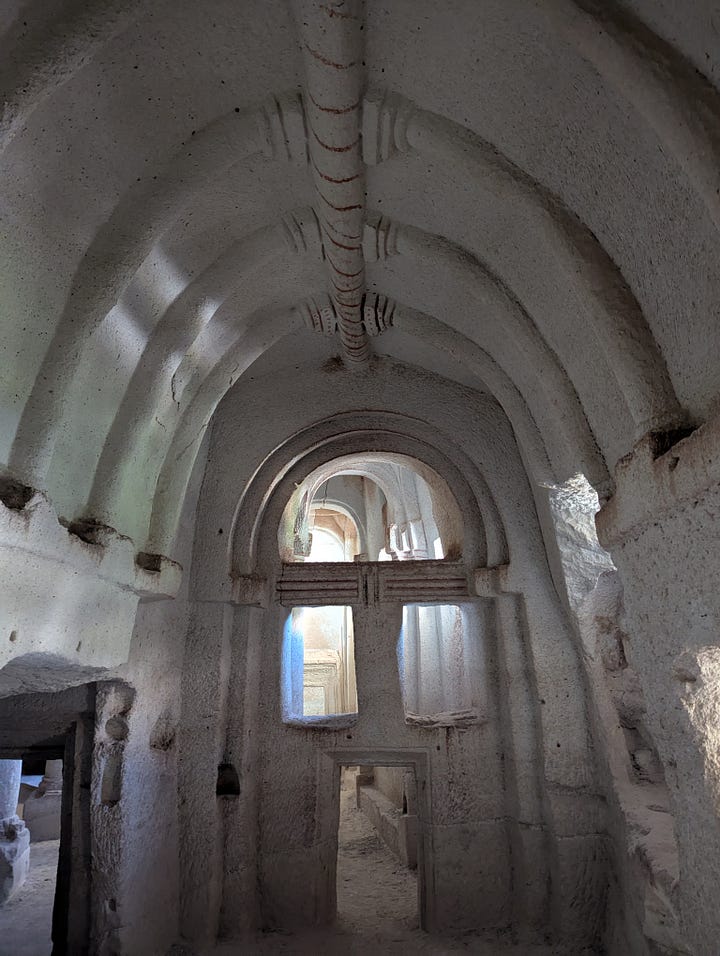
25-June-2025: We Did Nothing
We did basically nothing today. And not in the pleasant relaxing sort of way. Scott got a mild (but still bad enough to not want to be out and about) case of food poisoning from some sushi, so we stuck around the hotel and let that pass. Note to self: stay away from sushi in the middle of Turkey. We thought a restaurant in a very touristy place would be ok… but that turned out to be an overly optimistic assumption.
26-June-2025: Zemi and Sword Valleys
Tired of our early morning hikes and reasonably confident that the steep sided valley would be shady and cool, we made a daytime return to Zemi Valley. The pleasant valley walk as filled with birdsong, although not quite as much as it was when we had visited in the early morning a few days ago - perhaps even the birds prefer to avoid the heat of the day.
At the end of the valley, we tried to visit the ticketed Al Nazar Church. We had read it contained some beautiful frescos and we had hoped they may be better preserved due to the controlled access to the church. Unfortunately, it was locked tight and there wasn't anyone around. The sign for the ticket office and been turned around so it could not be read and despite the Turkish museum website suggesting it should be open for the season, it was clearly not (we are not sure if it is closed permanently or temporarily).
We continued onto Sword Valley. The valley is really a very narrow canyon that stretches between the Göreme open air museum and close to the entrance of Rose Valley. Some sections include ladders to climb down steep sections and the erosion patterns suggested the valley would be one to avoid if rain was in the forecast. After exiting the gorge, we returned to Göreme and caught a bus back to our hotel.
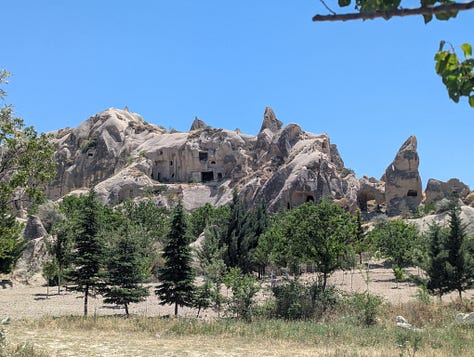
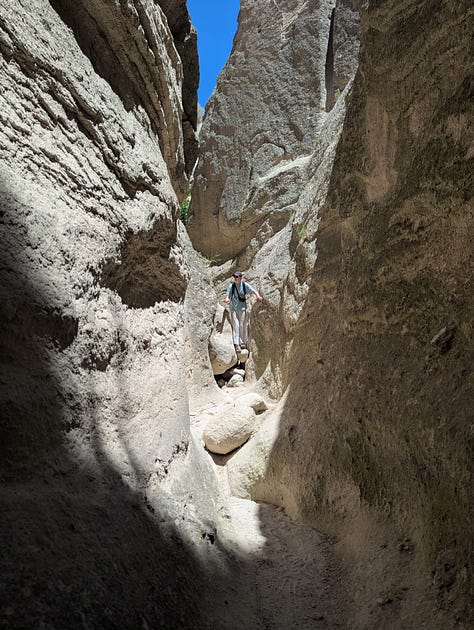
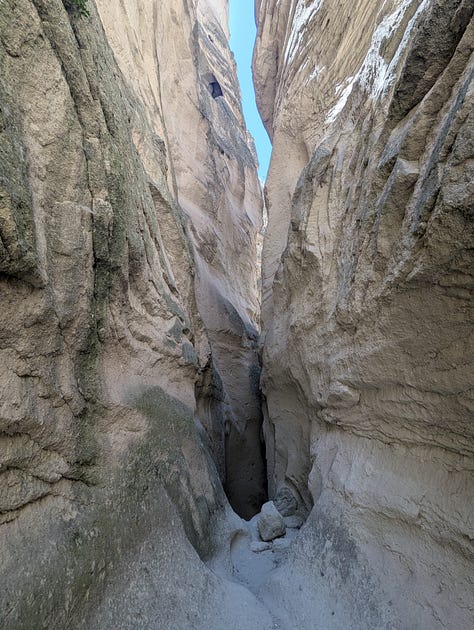
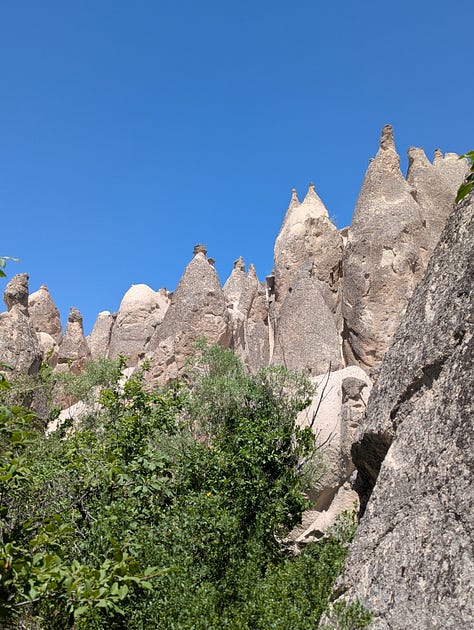
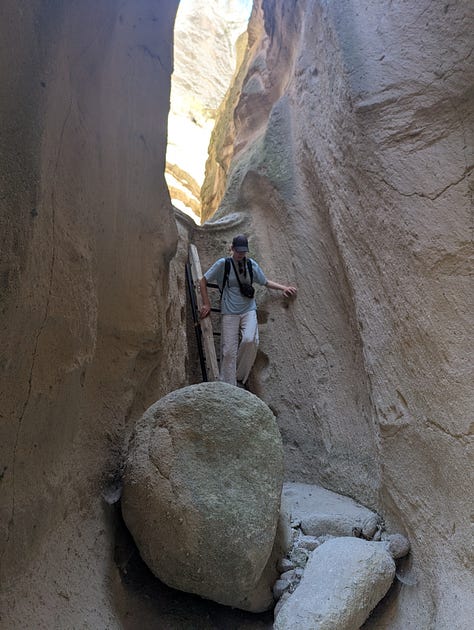
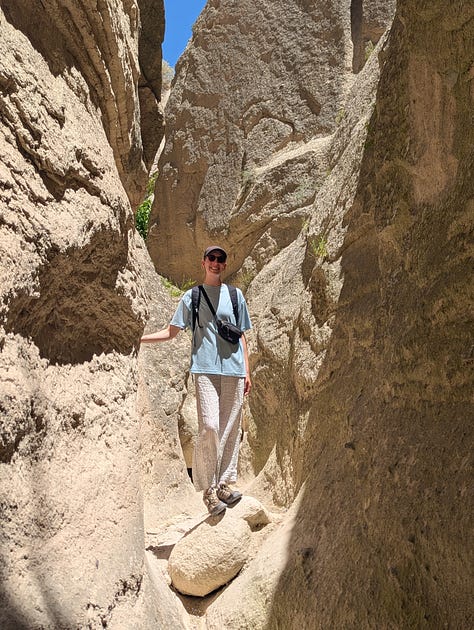
27-June-2025: An Underground City and Some Valleys Further Afield
Feeling that we had seen all we wanted to around the tourist centre that is Göreme, we decided to splash the cash and rent a car for a couple days. We found a well rated company called '“Sunset Rent a Car” which seemed to take an almost too relaxed approach to business - although a bit expensive at €60 per day, our two day rental had no mileage limits, full insurance (as long as we stayed on paved roads), and did not require a deposit. We contacted the company via WhatsApp and sent a picture of Scott's driver's license to confirm the reservation, but they didn't ask to see the physical license or an international driving permit (which we believe is required in Turkey). The only downside was that the fuel tank was on empty when Scott collected the car and we foolishly filled the tank - despite driving 500km, it was still at half when we returned the car.
En route to collect the car, Scott hitchhiked from Uçhisar to Göreme. The bus should run every half hour or so, but a kind Dutch-Turkish man stopped before any sign of the bus. He works at a travel agency in Göreme and explained the lack of tourists we had noticed - apparently fewer people come in the hot season, so we were visiting in a low season of sorts.
After collecting the car, we set off to our first stop: Derinkuyu Underground City. Despite being a popular stopping point, there was not much information on site. This is another Turkish place where research is required to fully appreciate the site. We had read a bit about Derinkuyu, but loitered near a tour group to listen to what their guide said (perhaps the lack of information is an effort to get tourists to pay for a guide when they visit). It was nice to have someone pointing features of the city out while walking through, but we were glad not to be on the “green tour” to many Cappadocian sites - the guide talked loudly and hurriedly; he seemed to rush through things a bit as they undoubtedly had an overfull day planned.
We looked up some additional information after our visit. This BBC travel article explains that the first levels of the city may have been dug by the Hittites sometime around 1200BC, although the origins are contested. Greek writings from 340BC mention Anatolians in the area living underground, so it's likely the city existed at that time. In any case Derinkuyu reached its largest extent in the Byzantine period when Islamic raids forced the area’s Christians to take shelter in the 7th century AD. Estimates suggest 20,000 people could hide out in the city for months at a time in 18 subterranean levels reaching a depth of 85 m (although we're pretty sure the part we visited only included 8 levels - perhaps some are not accessible or BBC counts differently, it's a maze down there after all). We made our way past kitchens, stables, wine pressing facilities, bedrooms, chapels, air shafts, and even a burial area during our visit. Even with modern lighting and occasional arrows to point the way, we found ourselves completely turned around for the entirety of our visit - and Mary felt a bit claustrophobic. Anyone trying to attack a hostile underground population by torch or lamp light over a thousand years ago would have been in for a nasty surprise, especially when multi tonne stones were used to close off sections or entire levels of the city!
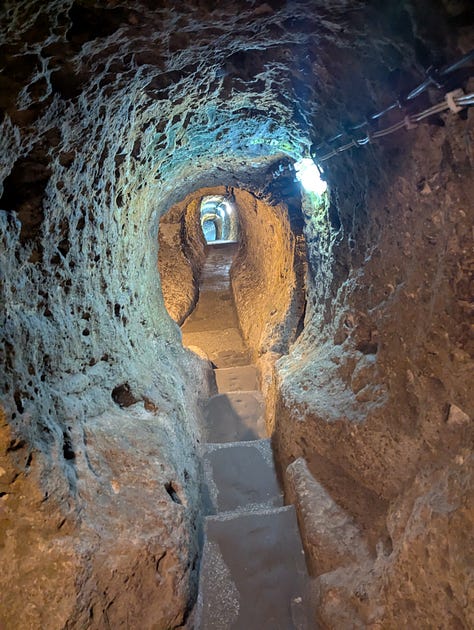

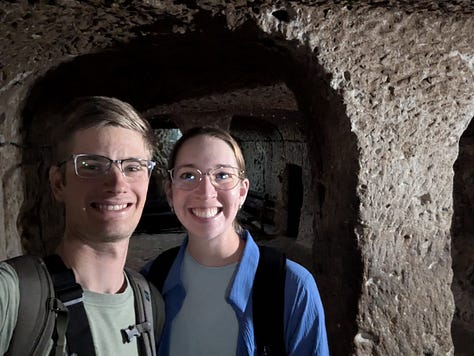
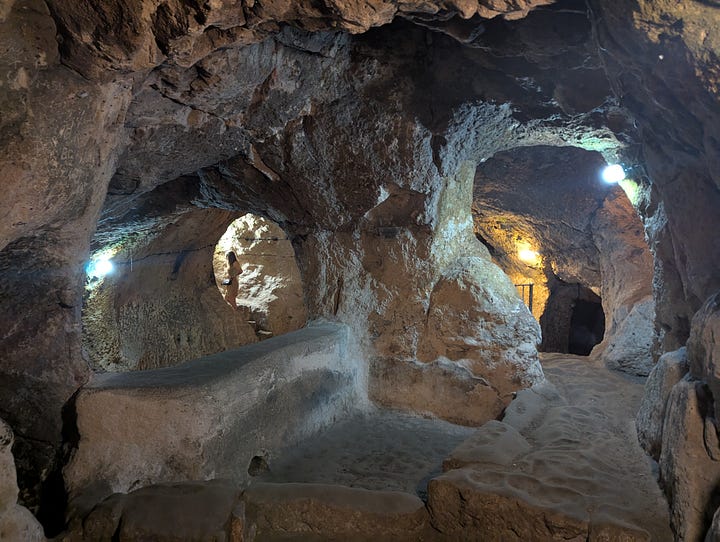
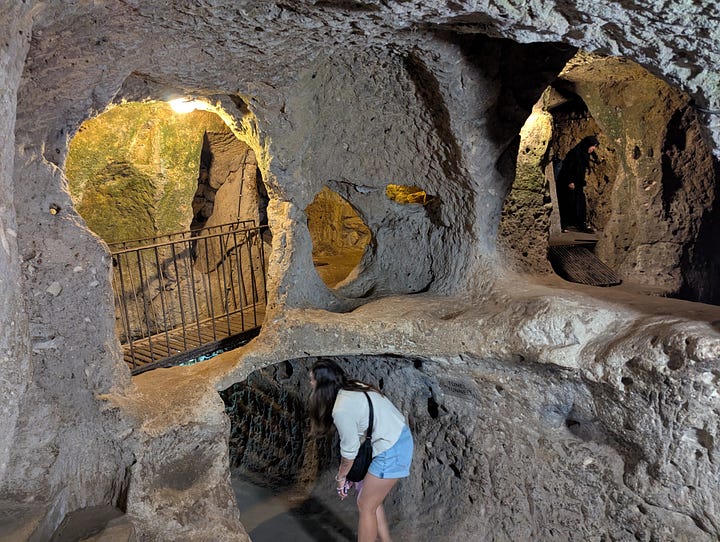
After returning to ground level, we set of toward another popular tourist destination: The Ihlara Valley. On route, we took advantage of having our own wheels and stopped at “And Narlıgöl Crater Lake Geothermal Field” (which wasn't overly exciting to be honest) and a valley of cave dwellings and churches called “Monastery Valley” near the modern town of Güzelyurt. Monastery Valley was deserted, so we could poke around and take photos in peace before heading back to the car.

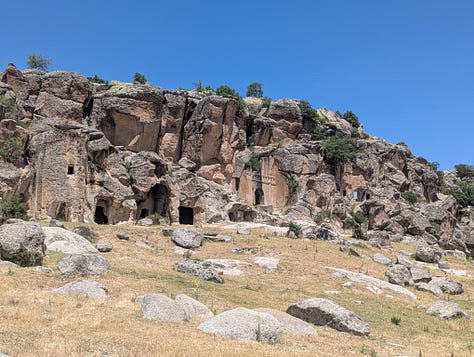
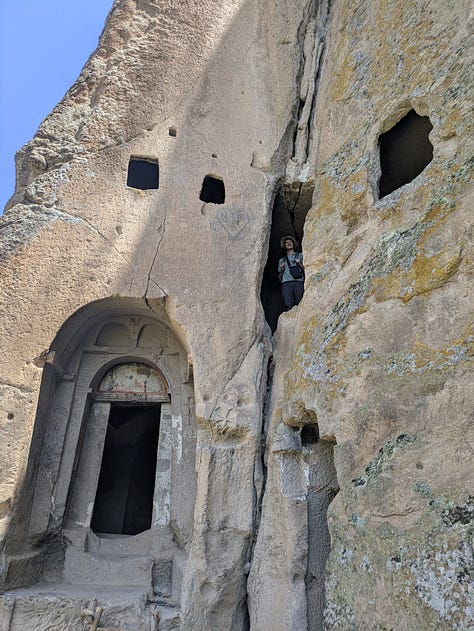
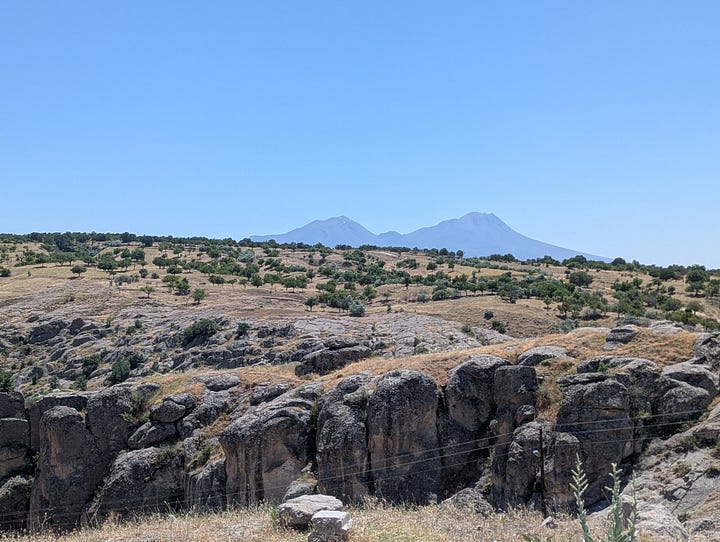
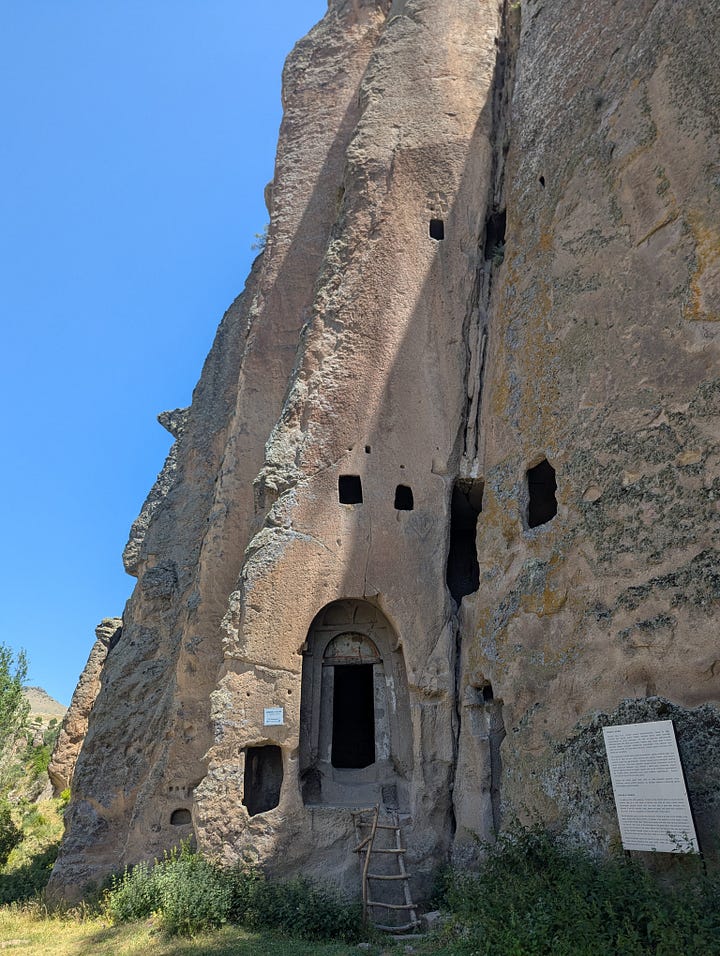
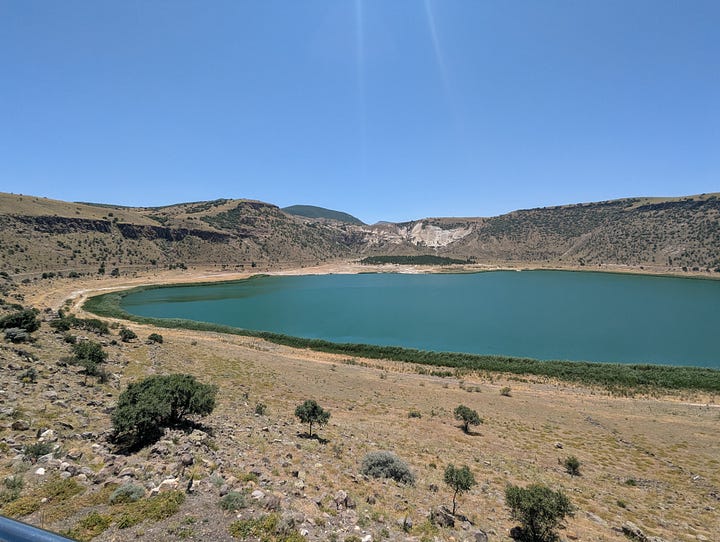
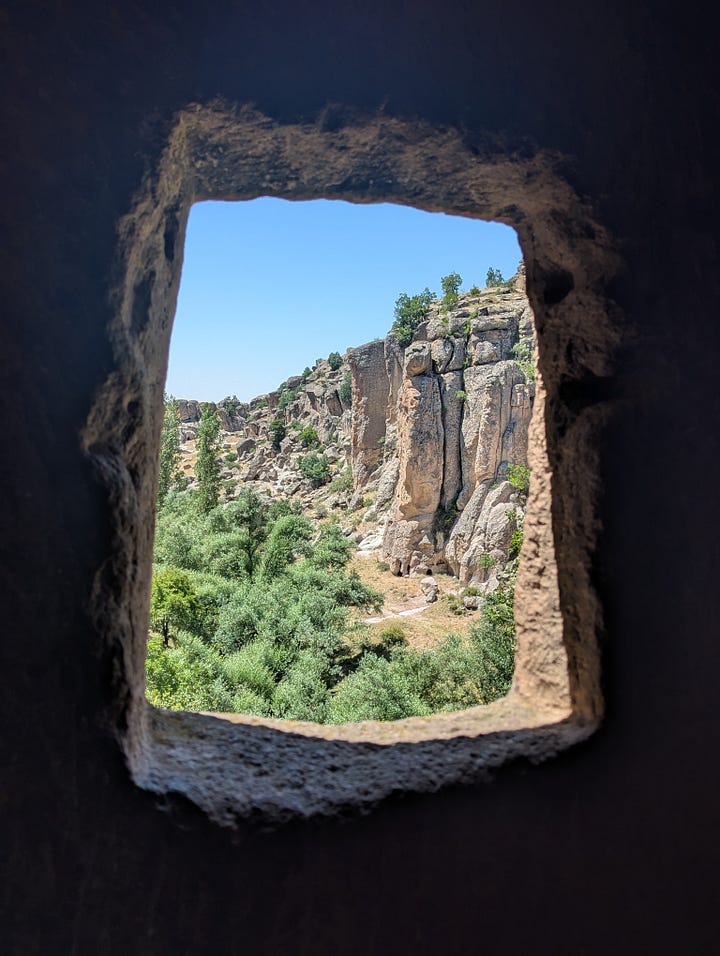
Ihlara Valley is known for a high concentration of frescoed churches and monasteries in a cliff lined valley with a reasonably sized river in the bottom. Admission is charged at €15 for tourists which seemed a bit on the expensive side, but generally worth the cost. We wandered through the valley past half a dozen or so churches in various states of preservation - some had rather impressive frescos dating between the 7th and 11th centuries while other had collapsed or been damaged my graffiti. The sign by one church said it had collapsed in 2011; it was a bit alarming that despite the admission charge the Turkish state didn't seem to be overly concerned about preserving such places.
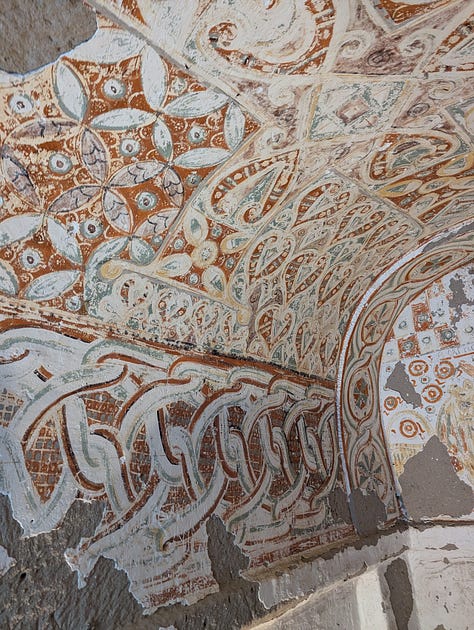

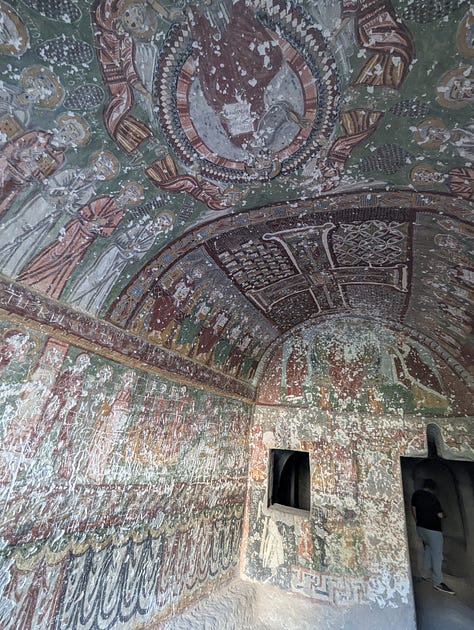

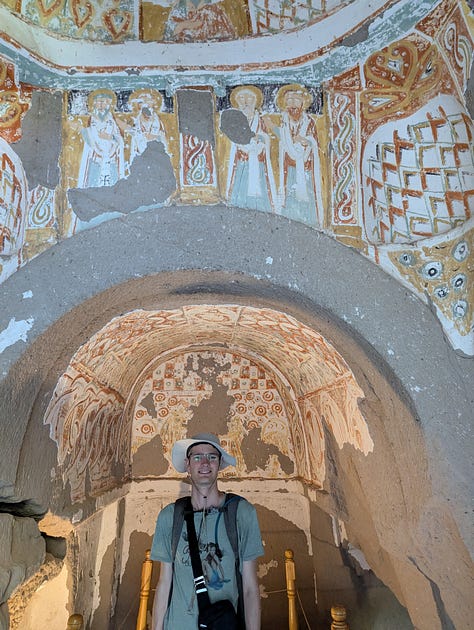
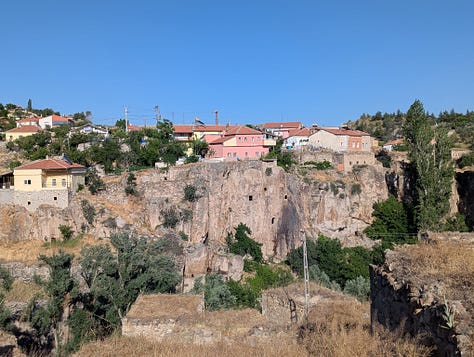
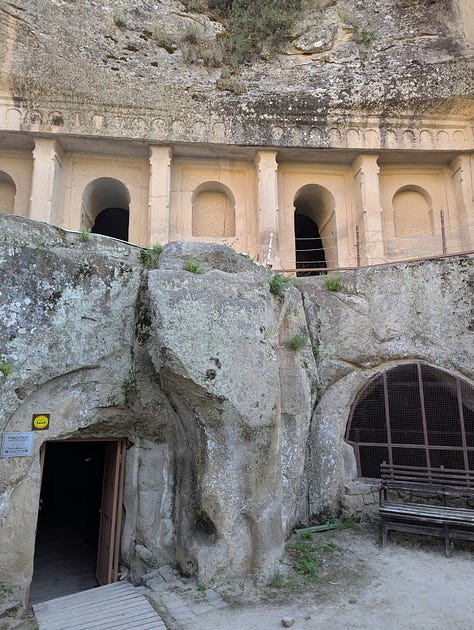
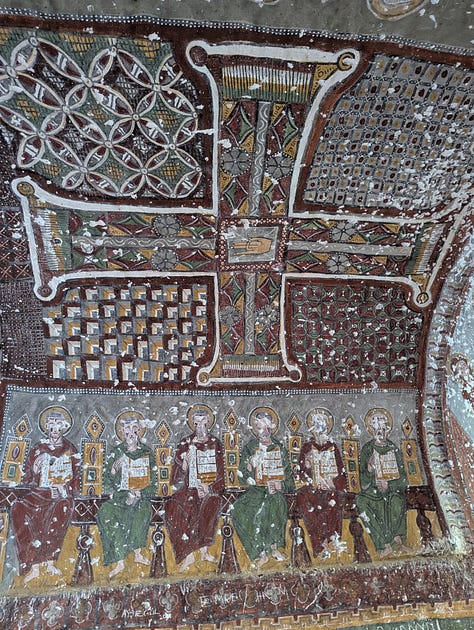

After our wander through the “church section” of the valley, we jumped back into the car and drove to the northern end of Ihlara Valley to see Selime Cathedral. Selime Cathedral (the larger area is also referred to as Selime Castle or Selime Monastery) is reported to be the largest such complex in Cappadocia. It is believed to have been carved as early as the 10th century and features massive halls, kitchens, a large Cathedral, and numerous other features carved into the rock. Unfortunately the frescos in the area are in a poor state of preservation, but we found the scale of the complex and it's position on the cliffside to be very impressive. Luckily admission is included with the Ihlara Valley ticket, so, paired with the frescoed churches in the valley, it was worth the €15 price tag.

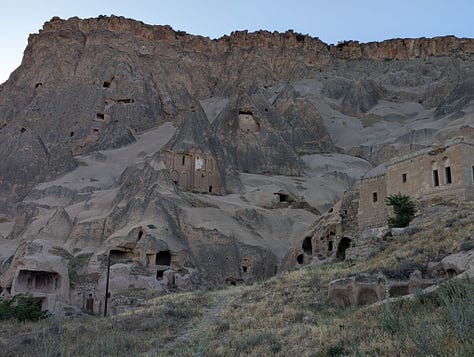
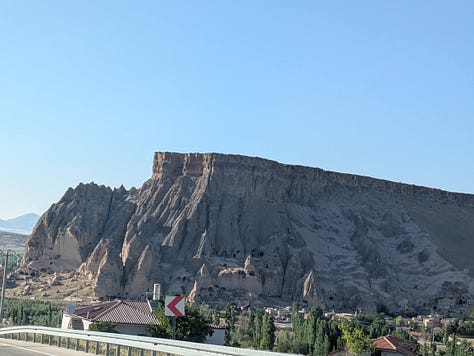
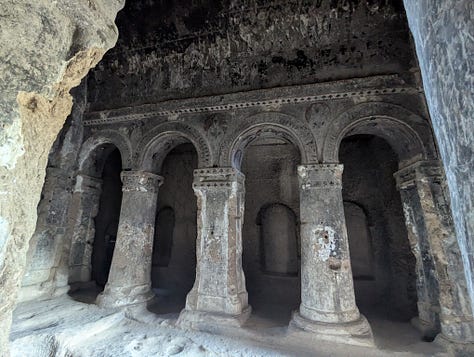
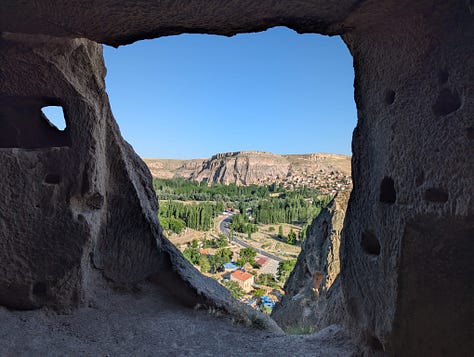
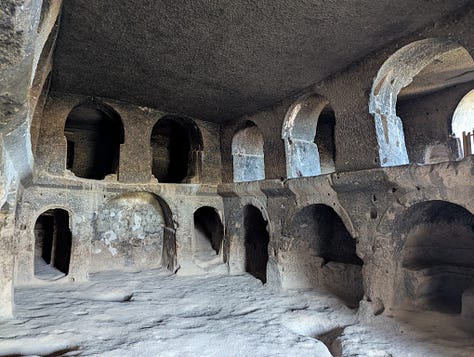
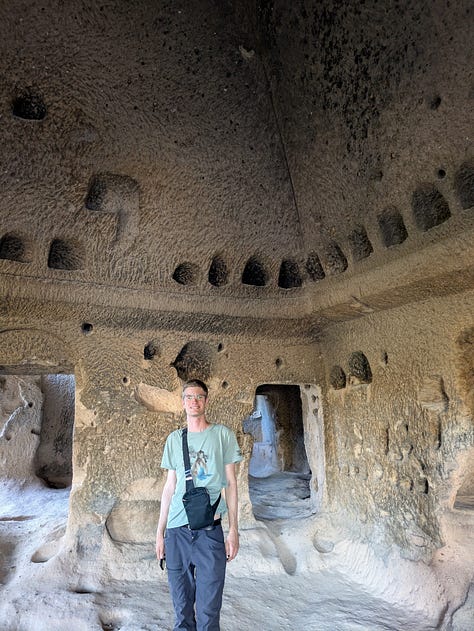

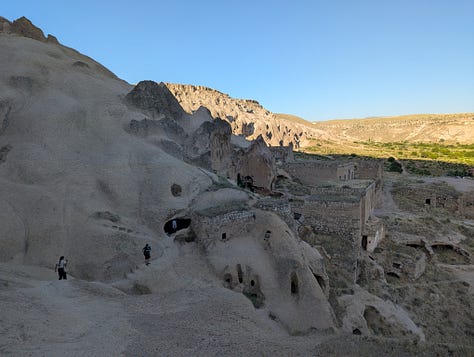
On the way back to Uçhisar, we attempted to stop at Ağzıkarahan caravanserai - a 13th century inn along the silk road. Unfortunately the caravanserai was closed when we arrived - despite google and the sign on the door saying it should have been open for another hour. Luckily it wasn't much out of our way, so we took a quick look at the decoratively carved entrance before getting back on the road.
28-June-2025: Gumusler Monastery and a Rural Turkish Drive
For our second day with the car, we decided to try and visit some sites a bit further afield which tend not to be on the oft advertised day trips from Göreme. Our first stop was Gumusler Monastery. The rock cut monastery is near the city of Nigde, just over an hour drive south of Göreme. The monastery included a number of levels below ground, a church with very well preserved frescos, and a massive open air courtyard cut from the rock. Although information about the site was limited (as seems to be a trend in Turkey), the visit was interesting and the tickets were more reasonably priced than other sites - only 140 lira per person.


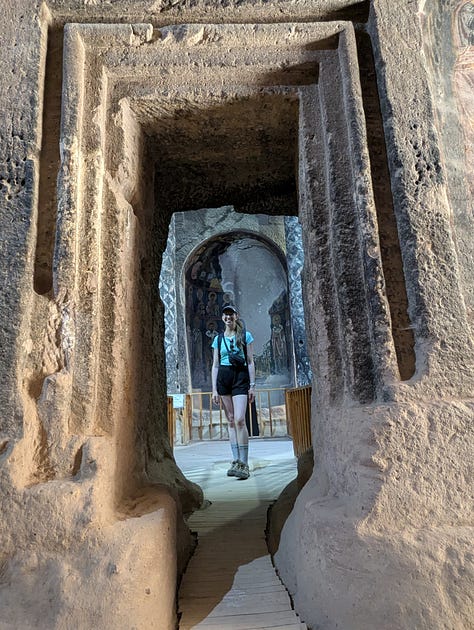
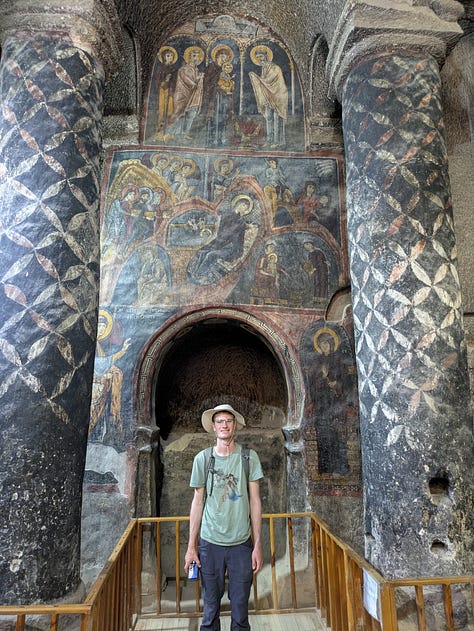
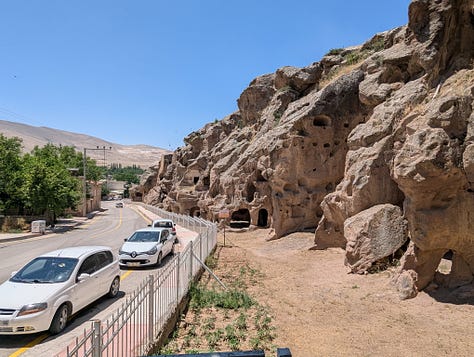
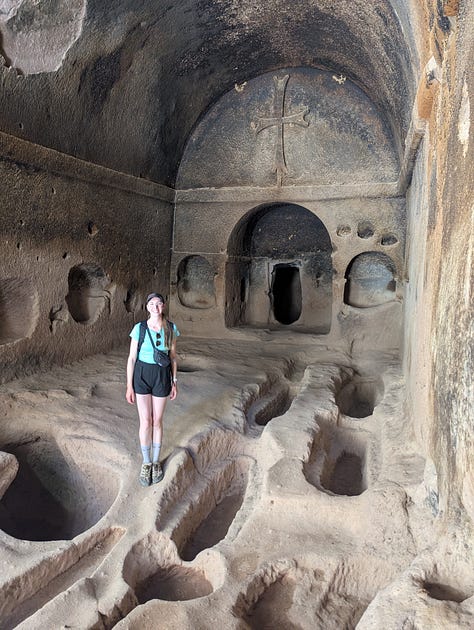

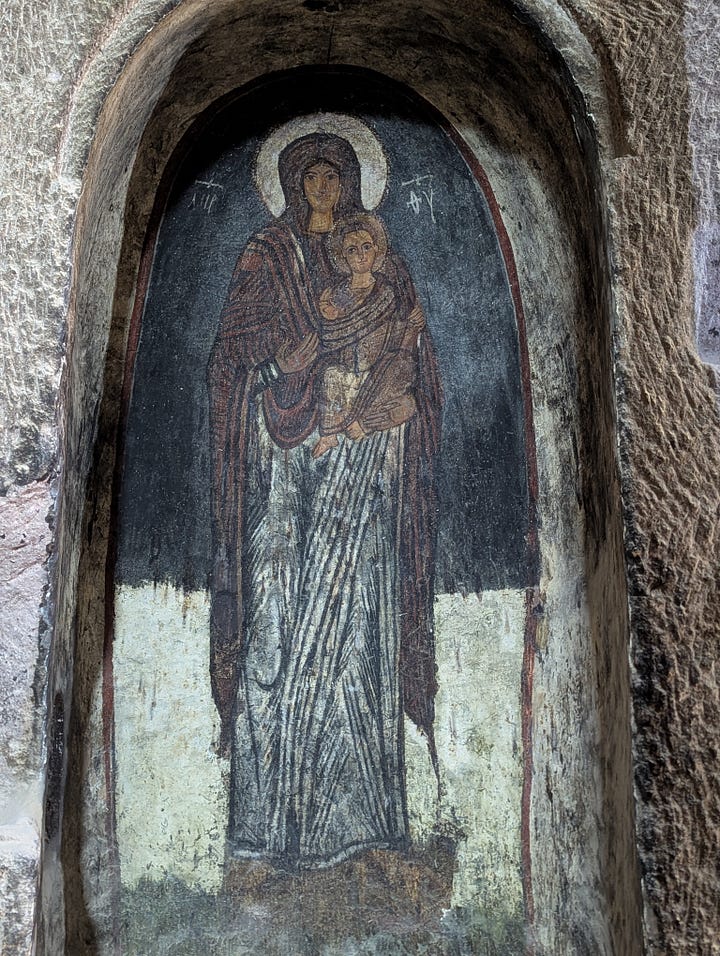
From the monastery, we took a scenic countryside drive to the edge of Aladaglar National Park. The park itself seems to be lacking in facilities, we didn't see any sort of visitors centre, roads in the park are very limited, and hiking trail information/marking is pretty much non-existent. Apparently the park is popular with mountaineers and includes numerous rock climbing routes. We found the north edge of the park striking for its almost complete lack of vegetation and the impenetrable looking rocky peaks rising towards the sky. We parked at a trailhead at an elevation of about 1650m and followed a rough trail for a kilometer or so up a gorge. Due to the heat, lack of shelter from the sun, and knowing that reaching the end of the canyon would require climbing quite a lot of elevation, we didn't venture further (despite the temptation of peaks reaching over 3500m in the distance).
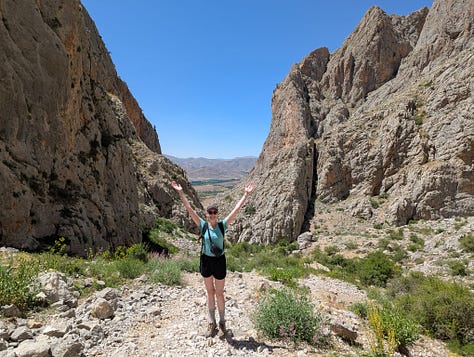
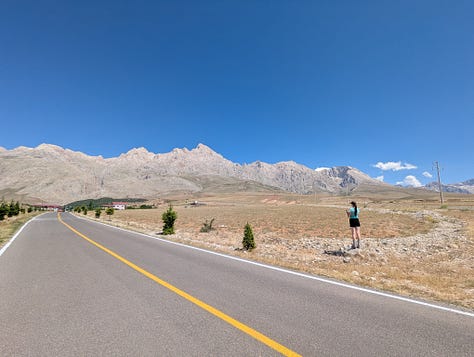
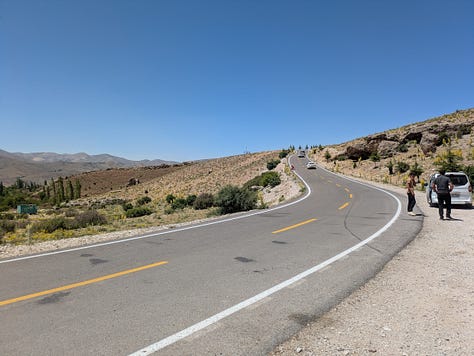
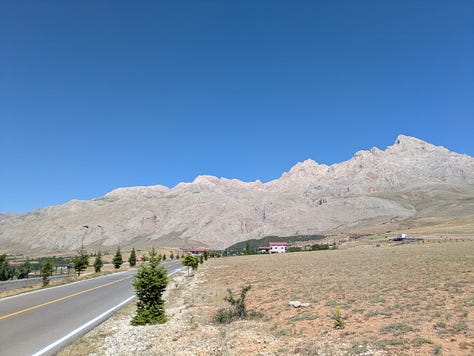
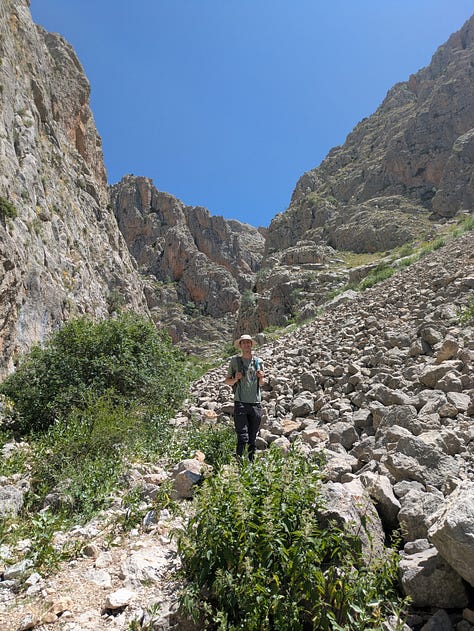
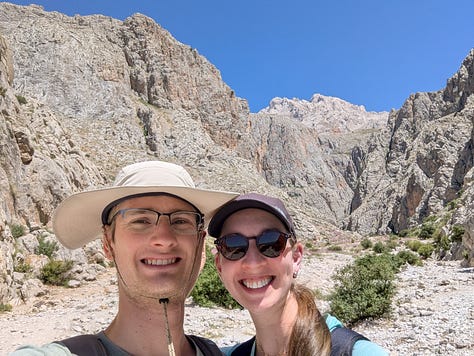
On our way back to Uçhisar, we followed winding country highways where we didn't see much except a few crumbling villages and a couple of herds of cows which a single man would attempt to keep off the road. Closer to Uçhisar, we made a brief stop in Soganli to stretch our legs, check out yet another church cut into the rock, and see a strange dragon statue. Although we didn't see quite as many attractions as usual, it was a nice change of pace to head out for a mini road trip and see some of the rural parts of Turkey.
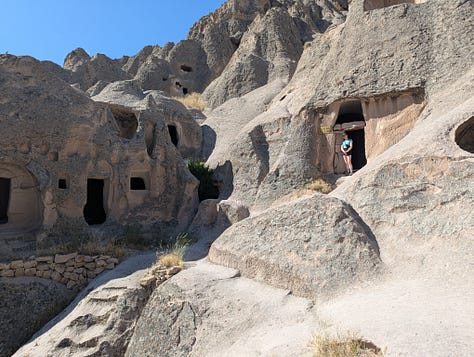
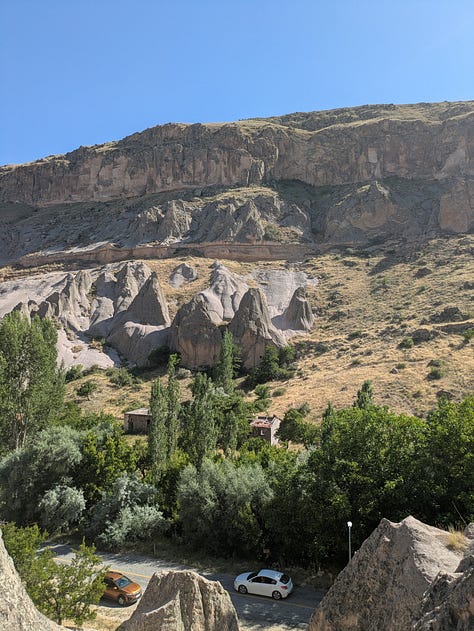
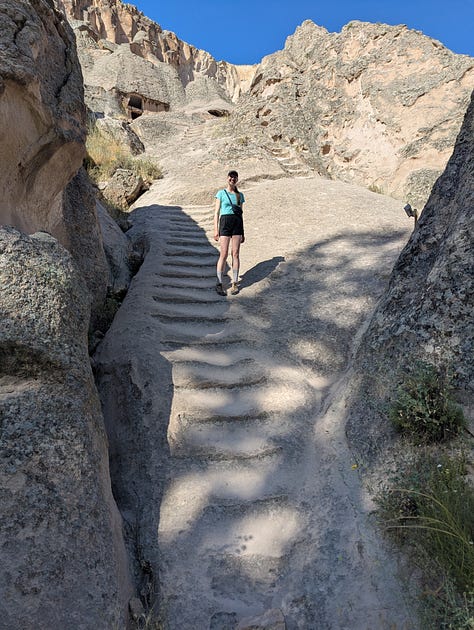

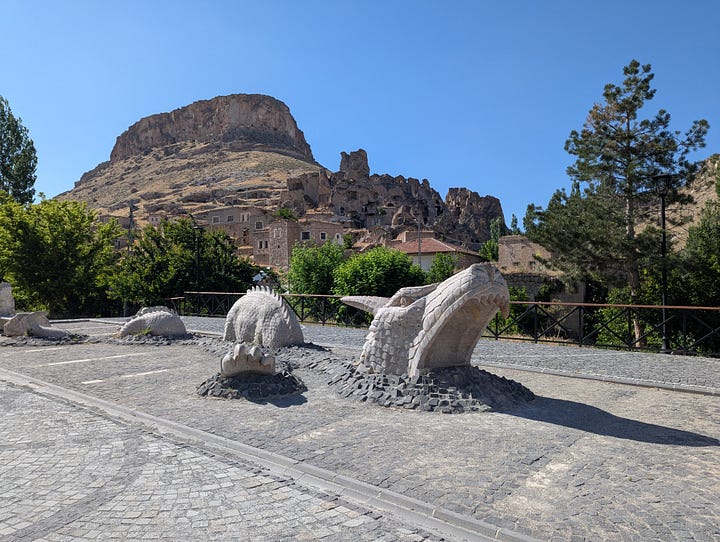
Notes on the Turkish Language:
While in Turkey, Mary has noted that certain Turkish words sound almost jarringly French. Initially we dismissed this observation, however the French-ish Turkish words continued to pile up so we had to look into it…
Some examples: “kuaför salonu” is Turkish for “hair salon” similar to the French “salon de coiffure”. “Lise” is used for highschool (which is lycée in French). “Otobüs garı” is bus station, “gare” is station in French and “autobus” is bus. We've had people ask if we are “Almanca” which means German, “Allemande” is German in French. “Otel” is Turkish for hotel, which is “hôtel”in French. Escalator is “asansör”, or “ascenseur” in French. “Büro” is office which is “bureau” in French.
A quick Google search revealed that there is in fact a reason for this: A large number of French loanwords are incorporated into the Turkish language. This is because at the start of the 19th century there was a period of reform and modernization of the laws and institutions of Ottoman empire. This was partly a response to pressure from Western European powers at the time. Turkey sent students and officials to study in Europe, and invited foreign experts to the Ottoman empire. These interactions and contact resulted in many French words entering the Turkish language, particularly in law, politics, science and culture.
Turkish is quite a flexible language, and over the years has absorbed many loanwords from other languages, particularly Arabic, Farsi, German, French, and English. The ability to absorb foreign vocabulary is common to many languages, especially when there is extensive contact with other cultures and languages, as is the case with Turkish.
Travel Stats
The bus from Konya to Göreme covered about 230km, taking us firmly into the centre of Turkey. With the rental car, we covered an additional 500km.
Wandering through the Cappadocian valleys, we clocked up 104.8km or about 15km/day on foot. This takes our 174 day total to 2390km.
To Be Continued…
After our week in Cappadocia, we had seen so many rock cut buildings that the wow factor had worn off a bit. We enjoyed our visit and had stayed about the right length of time. Next, we'll continue our journey north and east across Turkey. Keep an eye out for our next update to see where we end up!






